Crew-4 (Crew-4 mission on SpaceX's Crew Dragon spacecraft)
Human Spaceflight
Related resources
Crew-4 mission to the ISS
• April 27, 2022: Four American and European astronauts are on their way to the International Space Station after their launch on a Crew Dragon spacecraft April 27, less than two days after another spacecraft returned from the station. 1) 2)
- A SpaceX Falcon 9 lifted off from Launch Complex 39A at the Kennedy Space Center at 3:52 a.m. EDT (07:52 UTC), placing the Crew Dragon spacecraft Freedom into orbit 12 minutes later. The rocket’s first stage, which launched three previous missions including Crew-3, landed on a droneship in the Atlantic.
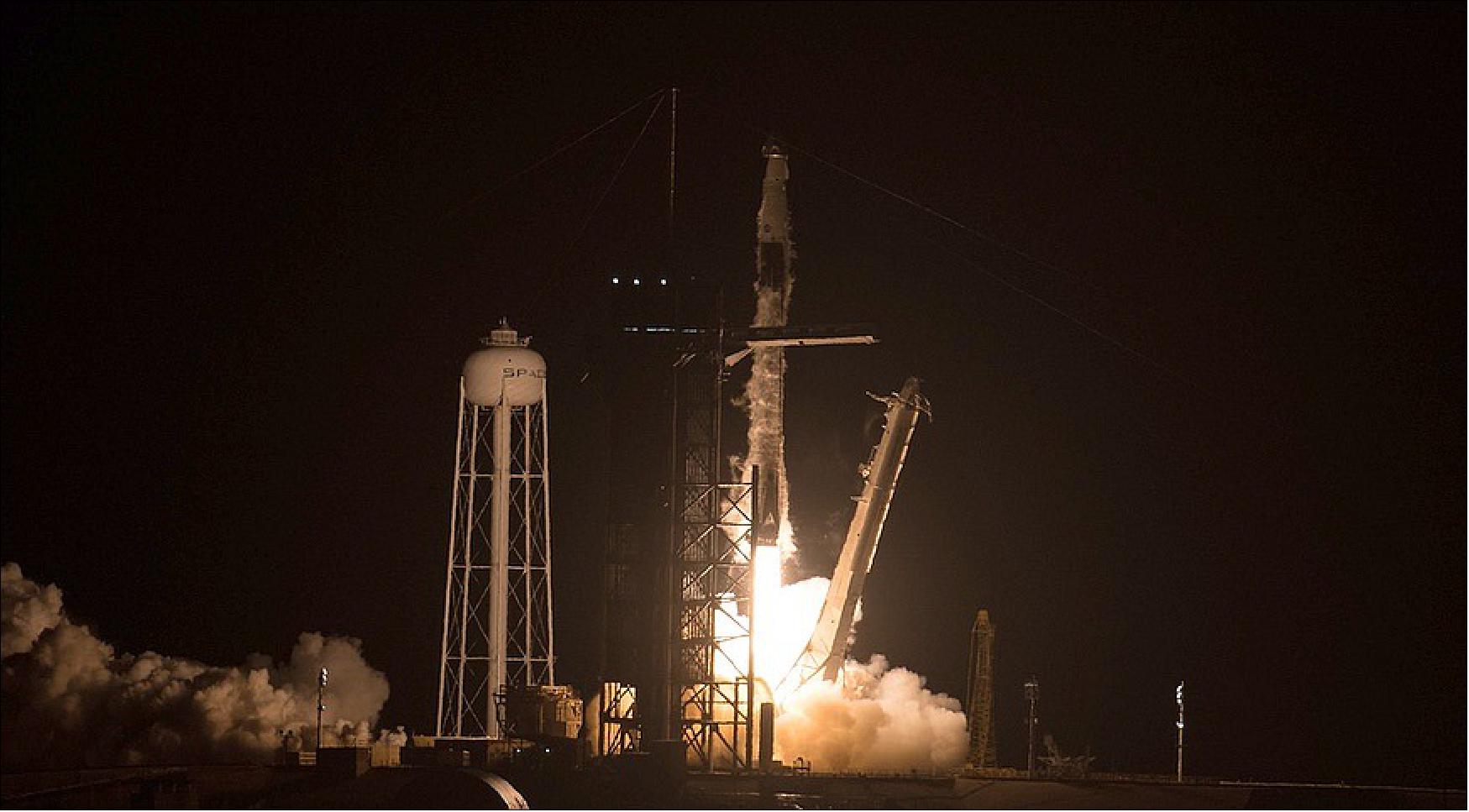
- The Crew-4 mission is commanded by NASA astronaut Kjell Lindgren with Bob Hines as pilot. NASA astronaut Jessica Watkins and European Space Agency astronaut Samantha Cristoforetti are mission specialists. The Crew Dragon is scheduled to dock with the ISS at 8:15 p.m. EDT (00:15 UTC on 28 April), a little more than 16 hours after liftoff.
- Freedom will use the same ISS docking port that was occupied just a few days earlier by another Crew Dragon spacecraft, Endeavour, that spent more than two weeks at the station for the Ax-1 private astronaut mission. The spacecraft undocked April 24 and splashed down off the Florida coast April 25, less than 39 hours before the Crew-4 liftoff.
- Both NASA and SpaceX officials said the short turnaround between the Ax-1 splashdown and Crew-4 launch was not an issue. “Engineers have been pouring over the data over the last 18 hours,” Steve Stich, NASA commercial crew program manager, said at a prelaunch briefing April 26 of reviews from the return of the Ax-1 mission. “It’s been a clean flight overall. No major issues.”
- NASA and Roscosmos also worked to squeeze in the arrival of Crew-4 around a spacewalk by two Russian cosmonauts, Oleg Artemyev and Denis Matveev, scheduled for April 28. Joel Montalbano, NASA ISS program manager, said at the prelaunch briefing that the traditional welcome ceremony for the Crew-4 astronauts will take place several hours after their arrival because the Russian cosmonauts will be asleep at the time of docking to stay on schedule for their spacewalk.
- NASA is planning a five-day handover between the new Crew-4 astronauts and the departing Crew-3 astronauts, who have been on the station since November 2021. Those four astronauts — NASA’s Raja Chari, Tom Marshburn, Kayla Barron and ESA’s Matthias Maurer — will depart in early May on the Crew Dragon spacecraft Endurance.
- The Crew-4 astronauts will remain on the station until September. The Crew-5 mission, set to use the same spacecraft, Endurance, as Crew-3, will launch that month, with Crew-4 expected to return by mid-September, shortly before the launch of the Soyuz MS-22 spacecraft. Crew-5 and Soyuz MS-22 may feature a seat exchange between an American astronaut and a Russian cosmonaut, if an agreement is completed by June.
- A hectic schedule will continue after Crew-4’s arrival with a second uncrewed test flight of Boeing’s CST-100 Starliner commercial crew vehicle, scheduled for May 19. A SpaceX cargo Dragon mission to the station will follow in June. Those missions may have to work around new attempts to perform a wet dress rehearsal of the Space Launch System.
- “Spaceflight tends to be a magnet of dynamic activities,” Montalbano said at the prelaunch briefing. “They all tend to draw together.”
- Upon their arrival at the space station, the Crew-4 astronauts will be greeted by NASA astronauts of the Expedition 67 crew already on board. During their six-month stay aboard the microgravity laboratory, Lindgren, Hines, Watkins, and Cristoforetti will join the Expedition 67 crew in conducting a number of science and research investigations. 3)
- The Crew-4 astronauts will conduct new and exciting scientific research in areas such as materials science, health technologies, and plant science to prepare for human exploration beyond low-Earth orbit and benefit life on Earth. Experiments will include studies on the aging of immune systems, organic material concrete alternatives, and cardiorespiratory effects during and after long-duration exposure to microgravity. These are just some of the more than 200 science experiments and technology demonstrations that will take place during their mission.
- Launching alongside the crew in the Dragon capsule is an investigation that seeks to restore meaningful vision to people suffering from retinal degenerative diseases like retinitis pigmentosa and macular degeneration. The Protein-Based Artificial Retina Manufacturing experiment tests the manufacturing of artificial retinas or retinal implants in microgravity, where it is expected their production could be optimized.
- Also traveling to space aboard the Crew Dragon are Smart-Tex shirts as part of the German Space Agency (DLR) investigation called Wireless Compose-2. The shirts are fitted with sensors, wiring, and a communications module to wirelessly transmit data to a base station. The shirt is designed to monitor cardiovascular activity like relative blood pressure and can provide details about heart contraction rate and valve opening and closing times – something normally accessible only through sonography or CT scans. These kinds of wearable technologies could be used to monitor health throughout a long-duration space exploration mission and could lead to a more flexible implementation of this technology in health monitoring equipment on Earth.
• April 25, 2022: ESA astronaut Samantha Cristoforetti is all smiles after arriving at NASA’s Kennedy Space Center in Florida, USA, last week with NASA astronauts Kjell Lindgren, Bob Hines and Jessica Watkins. 4)
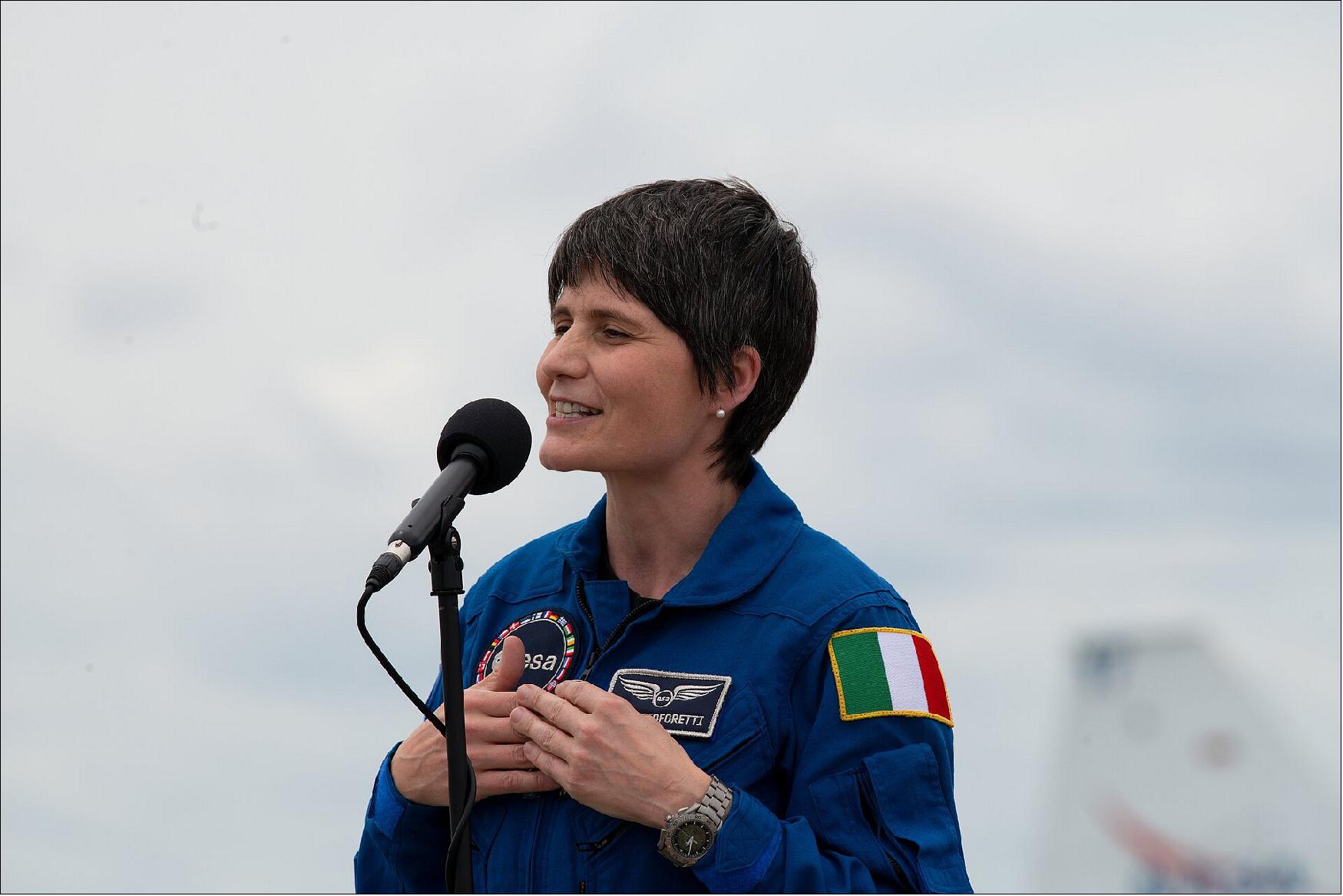
- Collectively known as Crew-4, the astronauts flew in from Houston, Texas, USA, and are spending the days ahead in quarantine before being launched this week to the International Space Station on the SpaceX Crew Dragon Freedom.
- “This is getting real,” said Samantha. “It’s very emotional for me, that this final stretch to the launchpad has started with the landing here, on this runway.” Samantha recalled her childhood fascination watching the Space Shuttle launches in the 1980s and her reality now: “I am landing on the Space Shuttle landing facility!”
- This is the second long-duration space mission for Samantha who first flew to the orbital outpost in 2014 for her Italian Space Agency ASI-sponsored mission Futura. This year’s ESA space mission, known as Minerva, will officially begin once she reaches the Station.
- Samantha will be welcomed to the Space Station by fellow ESA astronaut Matthias Maurer and enjoy a short handover in orbit before Matthias returns to Earth as part of Crew-3. - Throughout her mission, Samantha will hold the role of US Orbital Segment (USOS) lead, taking responsibility for all operations within the US, European, Japanese and Canadian modules and components of the Space Station. She will support around 35 European and many more international experiments in orbit.
- Samantha has the honour of many ‘firsts’ in her spaceflight career. She was the first astronaut to brew a cup of coffee in space.
- Her 2014 Futura mission held the record for the longest European space mission, at 199 days, until Thomas Pesquet’s mission Alpha in 2020.
- For mission Minerva, Samantha continues to trailblaze by being the first ever astronaut on social media platform TikTok, bringing space content and European research to a wider audience.
• April 20, 2022: The SpaceX Falcon 9 rocket, with Crew Dragon atop, rolled out to the launch pad on April 19, at Kennedy Space Center in Florida in preparation for NASA’s Crew-4 launch. The rocket is now in a vertical position at Kennedy’s Launch Pad 39A and underwent a successful dry dress rehearsal in the early morning hours of April 20 with the launch team and crewmembers. 5)
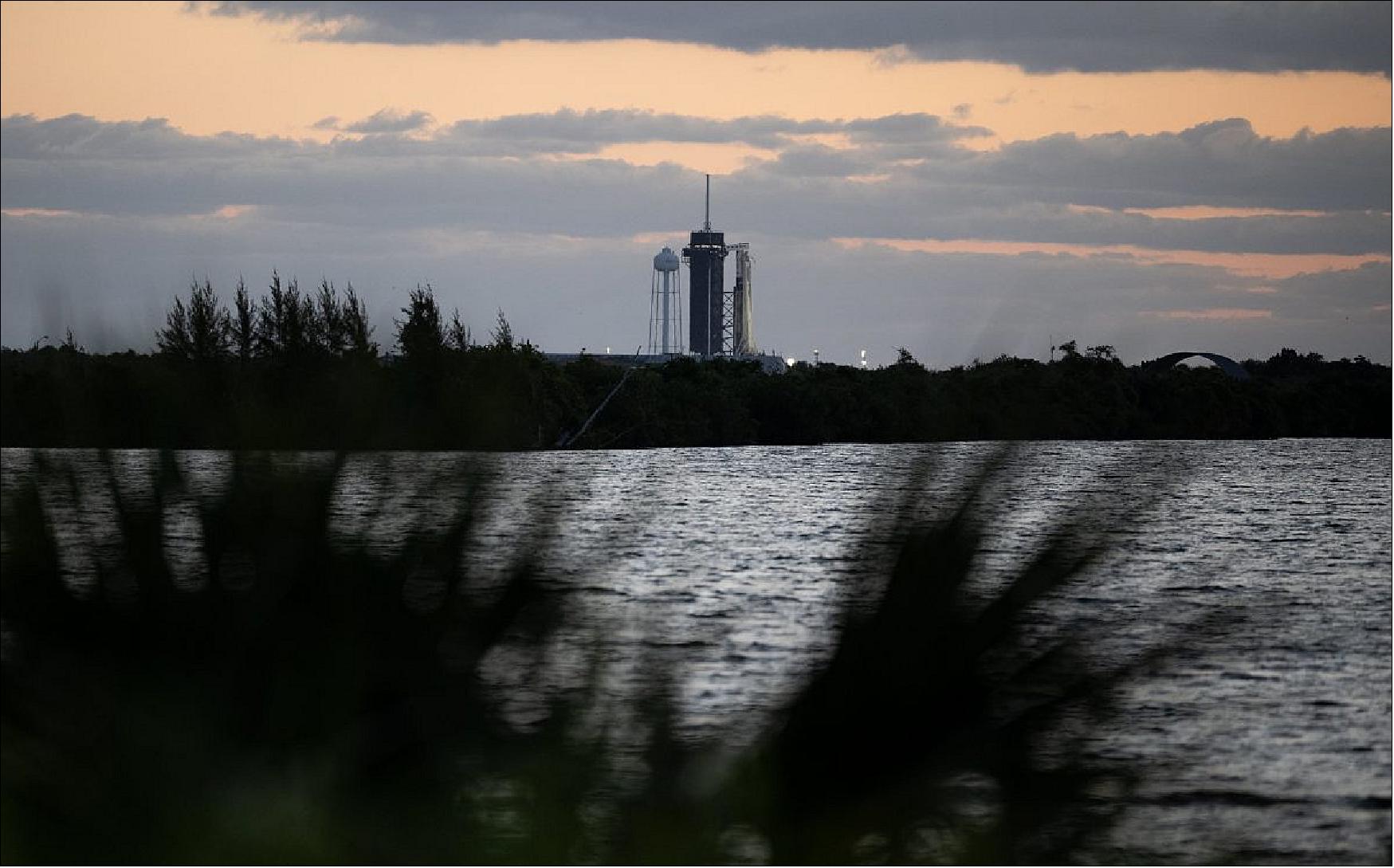
- The mission will carry NASA astronauts Kjell Lindgren, Robert Hines, and Jessica Watkins, and ESA (European Space Agency) astronaut Samantha Cristoforetti, to the International Space Station for their planned science mission. This is the first spaceflight for Hines and Watkins and the second flight for Lindgren and Cristoforetti.
- Upon their arrival, the Crew-4 astronauts will have a short overlap with NASA astronauts Raja Chari, Tom Marshburn, and Kayla Barron, and ESA (European Space Agency) astronaut Matthias Maurer, who flew to the station as part of the agency’s SpaceX Crew-3 mission in November 2021. Also on board are Roscosmos cosmonauts Oleg Artemyev, Denis Matveev, and Sergey Korsakov who flew to the station on a Soyuz spacecraft on March 18, 2022, Expedition 66 Commander Anton Shkaplerov and cosmonaut Pyotr Dubrov.
- The mission will fly a new Crew Dragon, which crew members have named Freedom. Mission Commander Lindgren tweeted the significance of the name: “The name celebrates a fundamental human right, and the industry and innovation that emanate from the unencumbered human spirit.” The spacecraft’s name also recalls Freedom 7, the spacecraft that carried Alan Shepard as the first American launched into space on May 5, 1961 aboard NASA’s Mercury-Redstone 3.
• April 8, 2022: Currently in quarantine in the USA ahead of her launch to the International Space Station, Samantha will be joined virtually by ESA Director General Josef Aschbacher, ESA Director of Human and Robotic Exploration David Parker, Italy’s Minister for Technological Innovation and Digital Transition Vittorio Colao and President of the Italian Space Agency ASI Giorgio Saccoccia to talk about her second space mission, Minerva. 6)
- Samantha first flew to the International Space Station in 2014, where she spent almost 200 days living and working in orbit for an Italian Space Agency ASI-sponsored mission known as Futura.
- Minerva will see her travel to the Station alongside NASA astronauts Kjell Lindgren, Robert Hines and Jessica Watkins on a SpaceX Crew Dragon spacecraft from NASA’s Kennedy Space Center in Florida, USA.
- These astronauts are collectively known as Crew-4 and their spacecraft is called Freedom.
- The targeted launch date for Crew-4 is no earlier than 21 April, with a backup date of 23 April.
- Once on Station, Samantha will be USOS Lead, responsible for all activities within the US Orbital Segment for the duration of her mission. This segment includes the US, European, Japanese and Canadian modules and components of the Space Station.
- She will also support numerous European and international experiments in orbit and is expected to have a short handover with ESA astronaut Matthias Maurer who is currently aboard the orbital outpost for his mission, Cosmic Kiss.
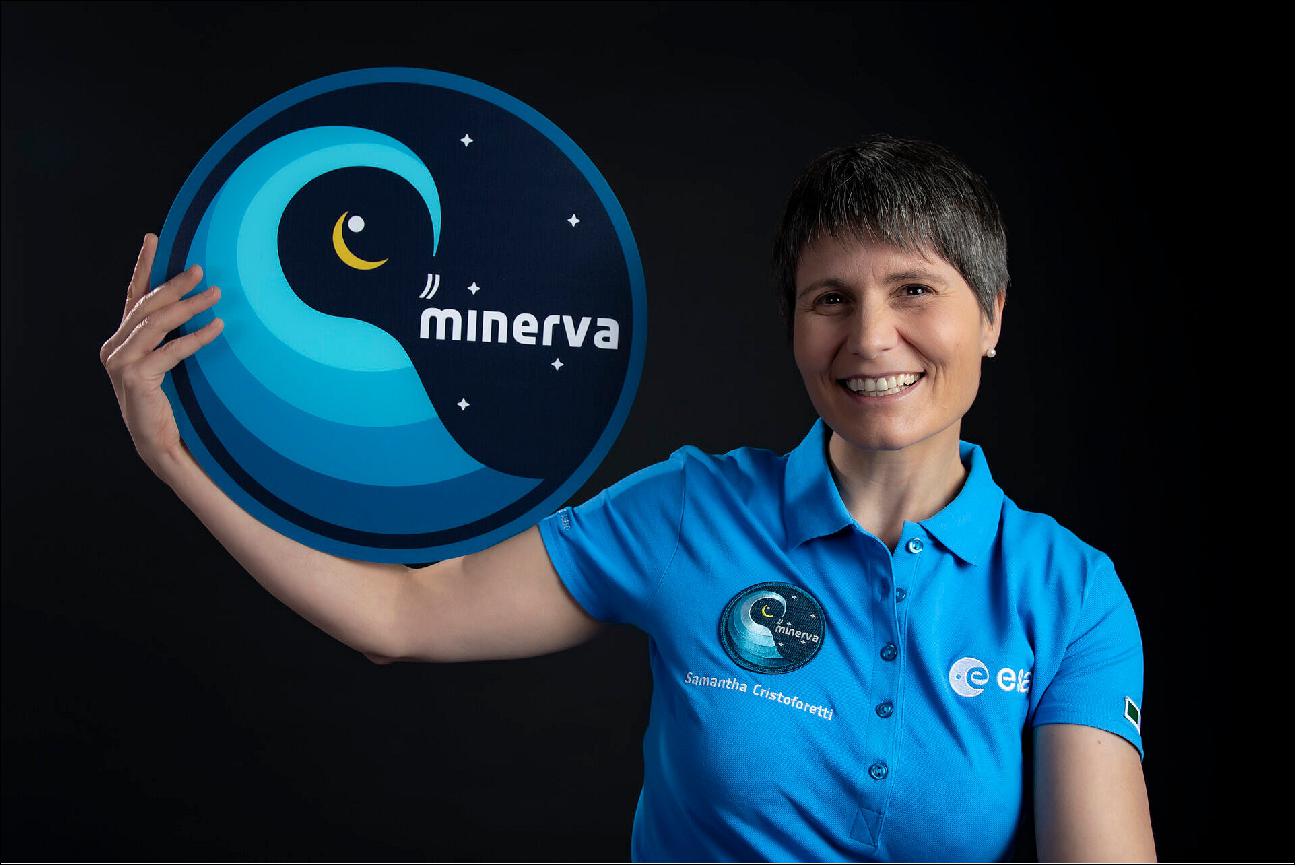
• March 18, 2022: Axiom Space and SpaceX are adjusting the launch date for the Axiom Mission 1 (Ax-1) to the International Space Station to allow teams to complete final spacecraft processing ahead of the mission. The Ax-1 crew will fly on Dragon Endeavour to and from the space station. After 10 days in orbit, the Ax-1 crew will splash down off the coast of Florida. 7)
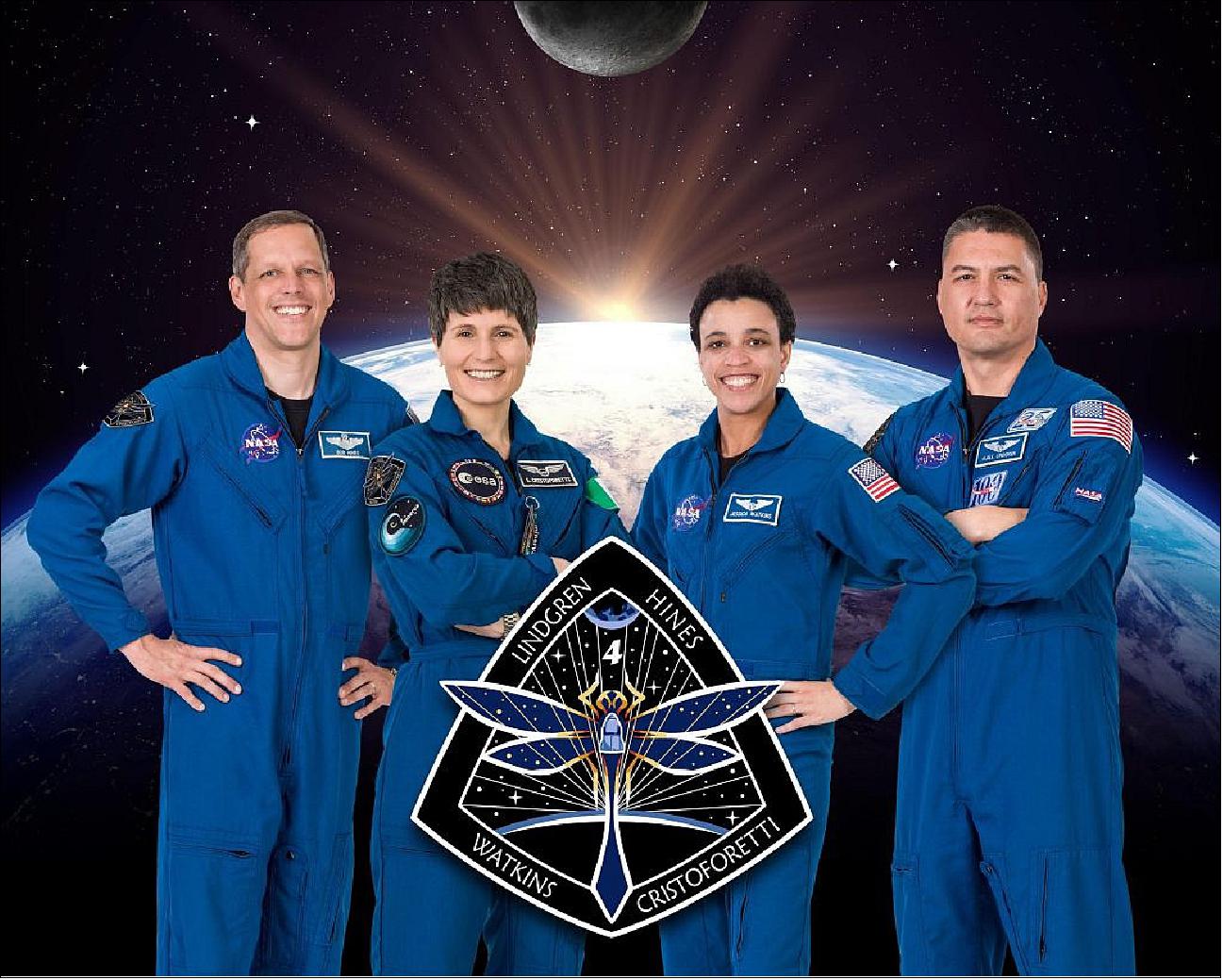
- NASA and SpaceX also will adjust the target launch date for the agency’s SpaceX Crew-4 mission to the International Space Station to allow appropriate spacing for operations and post-flight data reviews between human spaceflight missions and to allow for multiple consecutive launch attempts based on the orbital mechanics for arrival to the space station. The current no earlier than launch date is Tuesday, April 19, pending completion of program reviews expected early next week to formalize the new target.
- Crew-4 will carry an international crew of four astronauts to the orbital complex on a new Dragon spacecraft and flight proven Falcon 9 rocket for a science expedition mission.
• February 1, 2022: ESA astronaut Samantha Cristoforetti is all smiles alongside her Crew-4 mates during a training session at SpaceX headquarters in Hawthorne, California, USA. 8)
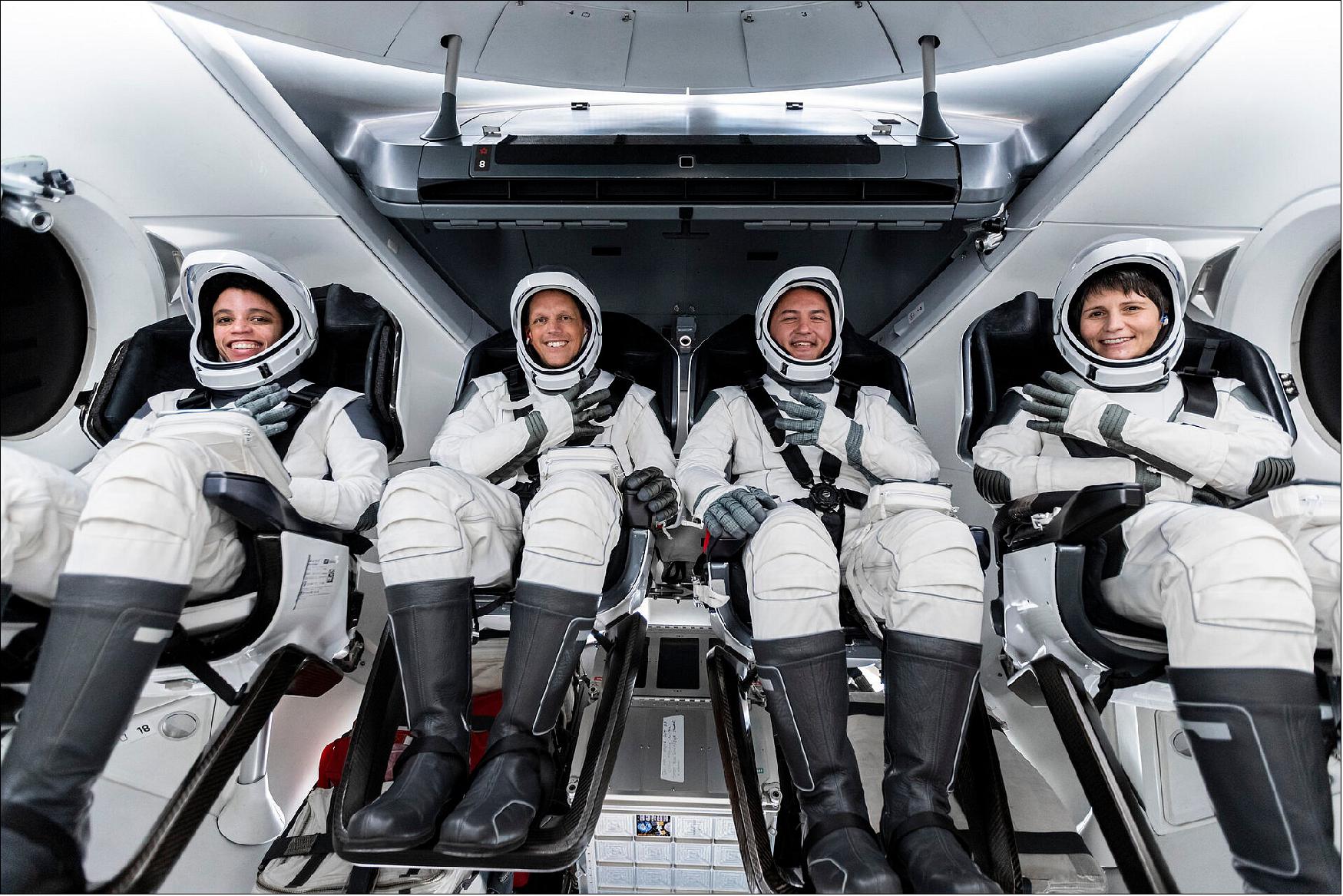
- Samantha is the next ESA astronaut to fly to space and is expected to be launched to the International Space Station in spring 2022. This is the second mission for Samantha who spent approximately 200 days in space in 2015 for her Futura mission.
- Samantha is launching with familiar faces. Fellow mission specialist Jessica Watkins was part of NASA’s NEEMO 23 crew, in which Samantha served as commander. The team spent 10 days living and working at the world's only undersea research station, Aquarius, located 19 m below the surface of the ocean off the coast of Florida.
- Upon hearing the announcement, Samantha tweeted her congratulations, saying: “So proud of you, Watty! After sharing the @NASA_NEEMO adventure on NEEMO23, I’m grateful to have you as a crewmate again on #Crew4. It will be fun!”
- Rounding off Crew-4 are NASA astronauts Kjell Lindgren as the commander and Bob “Farmer” Hines as pilot of their SpaceX Crew Dragon spacecraft. This is Kjell’s second flight and Bob’s first.
- Samantha is the third European astronaut to launch on SpaceX, after Thomas Pesquet in early 2021 and current ESA astronaut-in-space Matthias Maurer in late 2021.
- Training for Samantha’s second mission has included International Space Station refresher sessions at ESA’s European Astronaut Centre in Cologne, Germany, NASA’s Johnson Space Center in Houston, Texas and Roscosmos’s Gagarin Cosmonaut Training Centre in Star City, Moscow.
• March 10, 2022: “Minerva” is the name of ESA astronaut Samantha Cristoforetti’s second mission to the International Space Station. Inspired by the Roman goddess of wisdom, the handicrafts and the arts, this name is a homage to the competence and sophisticated craftmanship of the men and women all over the world who make human spaceflight possible. The goddess Minerva also embodies the toughness and discipline that is required of us, and the wisdom we wish to demonstrate, as we consolidate and expand human presence in space. 9)
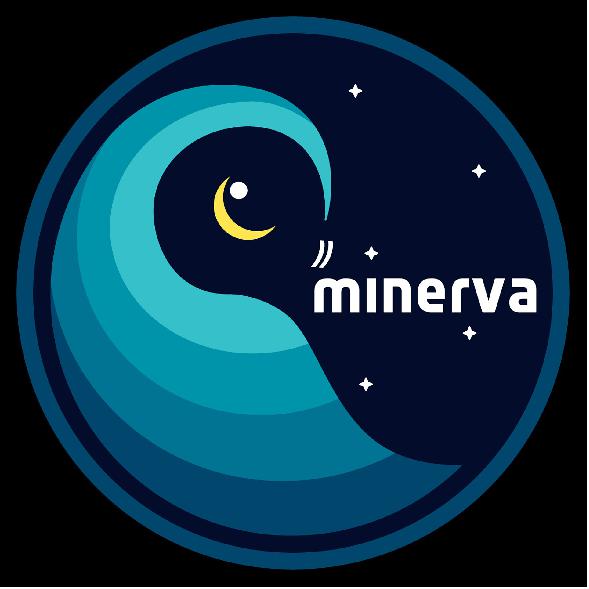
• November 16, 2021: NASA has assigned astronaut Jessica Watkins to serve as a mission specialist on the agency’s upcoming SpaceX Crew-4 mission, the fourth crew rotation flight of the Crew Dragon spacecraft to the International Space Station. 10)
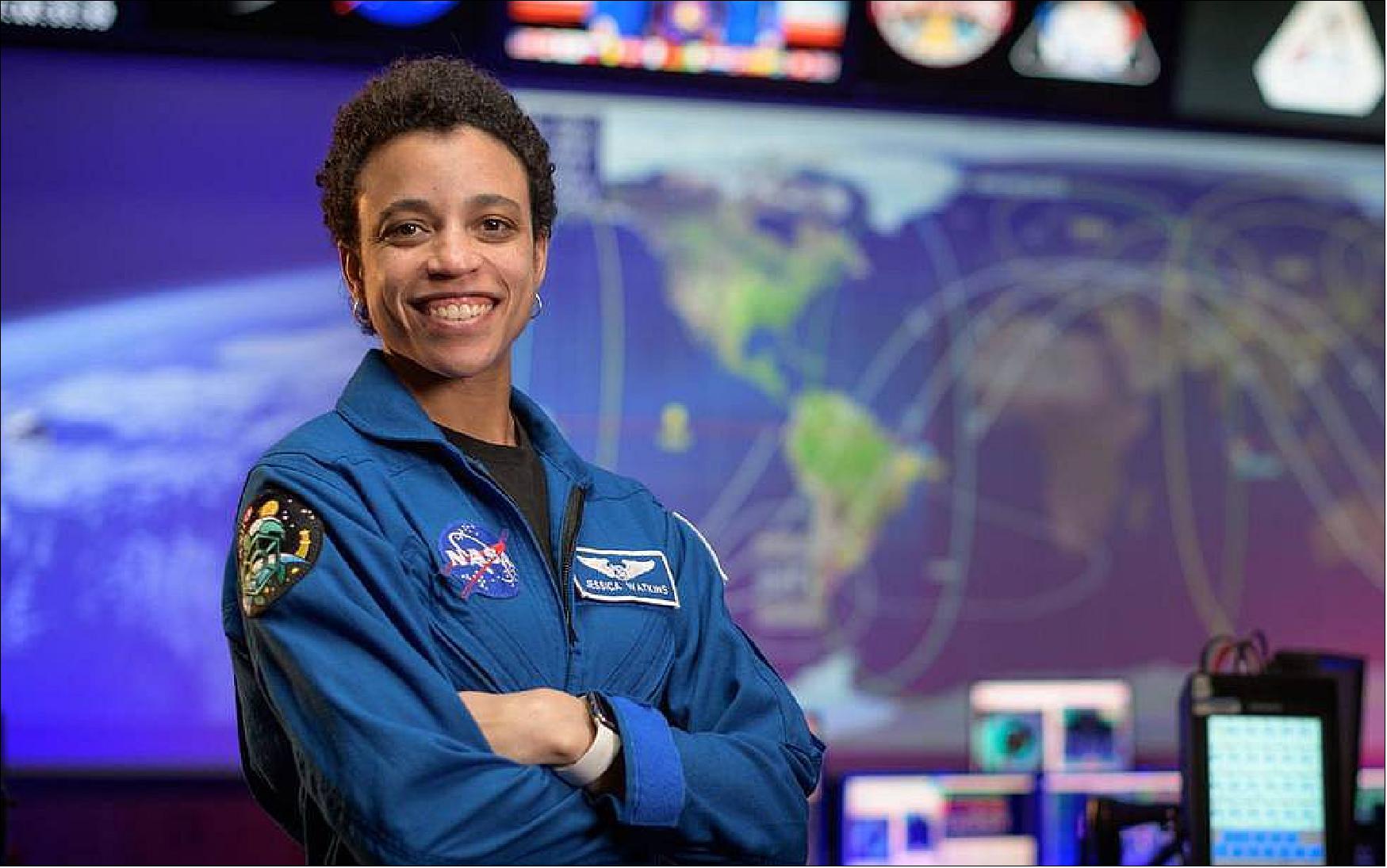
- This will be Watkins’ first trip to space following her selection as an astronaut in 2017. Watkins joins NASA astronauts Kjell Lindgren and Robert Hines, as well as ESA (European Space Agency) astronaut Samantha Cristoforetti, as a crew member for the Crew-4 mission.
- NASA previously announced the assignments of Lindgren and Hines as spacecraft commander and pilot, respectively, in February, and ESA announced Cristoforetti as a mission specialist for the mission in May.
- Crew-4 is scheduled to launch in April 2022 on a SpaceX Falcon 9 rocket from Launch Complex 39A at NASA’s Kennedy Space Center in Florida for a six-month science mission aboard the microgravity laboratory.
- Watkins was born in Gaithersburg, Maryland, and considers Lafayette, Colorado, her hometown. She earned a bachelor’s degree in geological and environmental sciences from Stanford University and a doctorate in geology from the University of California, Los Angeles. Dr. Watkins conducted her graduate research on the emplacement mechanisms of large landslides on Mars and Earth. She began her career at NASA as an intern and has worked at the agency’s Ames Research Center in California and NASA’s Jet Propulsion Laboratory in Southern California. At the time of her astronaut selection, Watkins was a postdoctoral fellow in the Division of Geological and Planetary Sciences at the California Institute of Technology, where she collaborated as a member of the Science Team for the Mars Science Laboratory rover, Curiosity.
- For more than 21 years, humans have lived and worked continuously aboard the International Space Station in low-Earth Orbit, advancing scientific knowledge, demonstrating new technologies, and making research breakthroughs not possible on Earth.
- Through the Commercial Crew Program and broader commercial efforts, NASA is working with private industry to develop human space transportation services and a robust low-Earth orbit economy that enables the agency to focus on building spacecraft and rockets for deep space missions to the Moon and Mars.
Mission Status
• July 01, 2022: ESA astronaut Samantha Cristoforetti and her Expedition 67 crew mates say goodbye to the Northrop Grumman Cygnus spacecraft as it departs the International Space Station. Samantha posted these images to her Twitter account on 28 June 2022 with the following caption: "Last night on ISS for Cygnus! Vehicle is fully loaded, hatch is closed, robotic arm has grappled it for unberthing early tomorrow morning. Thanks for bringing us supplies, for the orbit reboost and .... last but not least .... for taking our trash! MissionMinerva." 11)
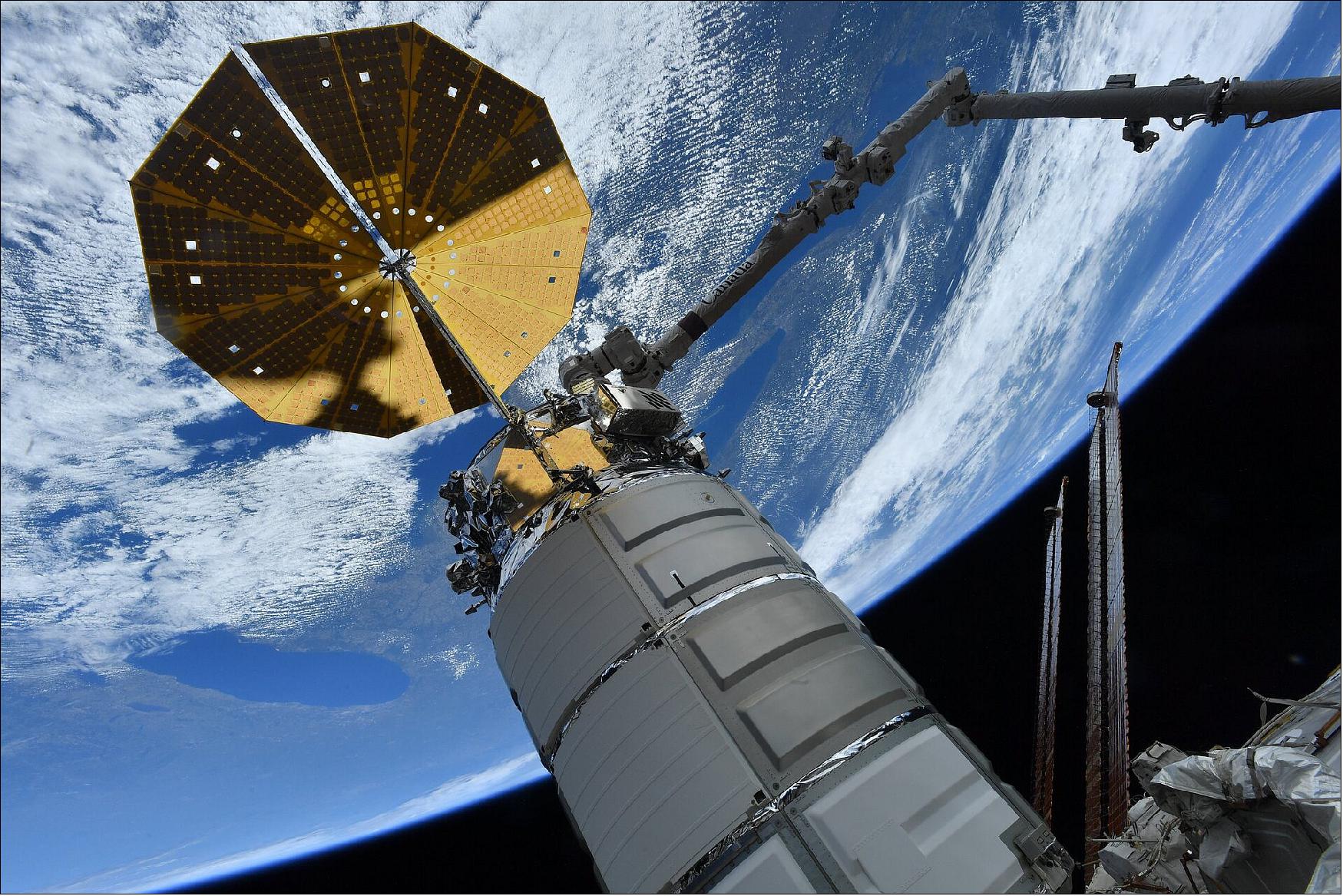
• June 28, 2022: NASA and SpaceX now are targeting no earlier than Thursday, July 14, for launch of the CRS-25 commercial resupply services mission to the International Space Station. The new target launch date supports ongoing Dragon spacecraft inspections as well as repair and replacement of any components that could have degraded by exposure to mono-methyl hydrazine (MMH) vapor found during testing in early June. In order to allow a more detailed off-vehicle inspection of the parachutes, the SpaceX team made the decision to replace the main parachutes on this spacecraft. 12)
- The new date also allows for launch of the uncrewed cargo mission for the earliest possible rendezvous opportunity with the International Space Station following the upcoming high-beta angle period when the sun angle with space station’s orbital plane causes problems with thermal and power generation at the microgravity laboratory in the planned docking attitude for visiting spacecraft.
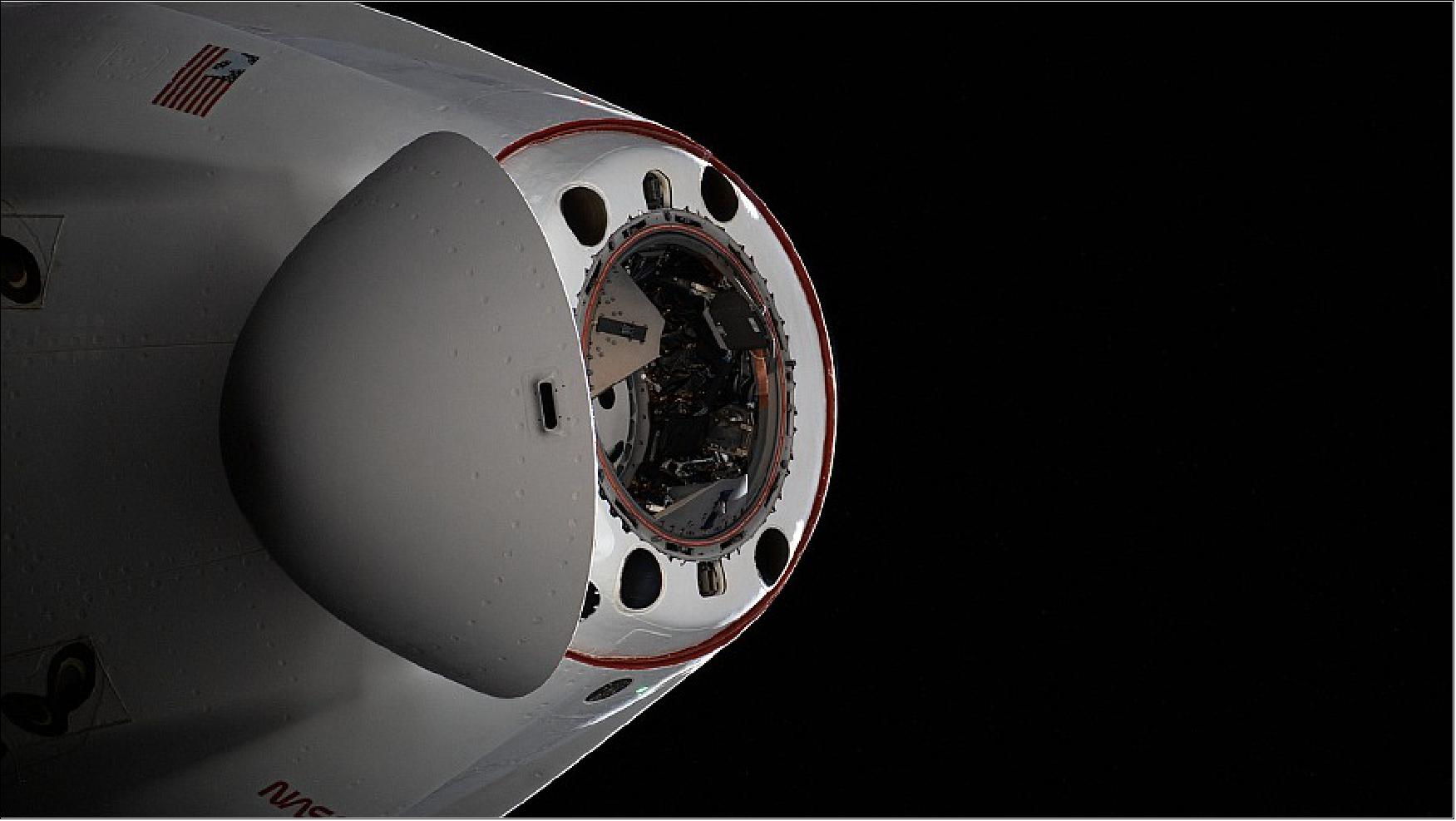
• On Saturday, June 25, Northrop Grumman’s Cygnus completed its first limited reboost of the International Space Station. Cygnus’ gimbaled delta velocity engine was used to adjust the space station’s orbit through a reboost of the altitude of the space station. 13)
- The maneuver lasted 5 minutes, 1 second and raised the station’s altitude 1/10 of a mile at apogee and 5/10 of a mile at perigee. This Cygnus mission is the first to feature this enhanced capability as a standard service for NASA, following a test of the maneuver which was performed in 2018 during Cygnus’s ninth resupply mission. Cygnus arrived to the orbital outpost in February and is slated to depart from space station Tuesday, June 28, where it will burn up harmlessly in the Earth’s atmosphere. NASA TV coverage for the unberthing will begin at 5:45 am EDT on NASA TV, the agency’s website, and the NASA app.
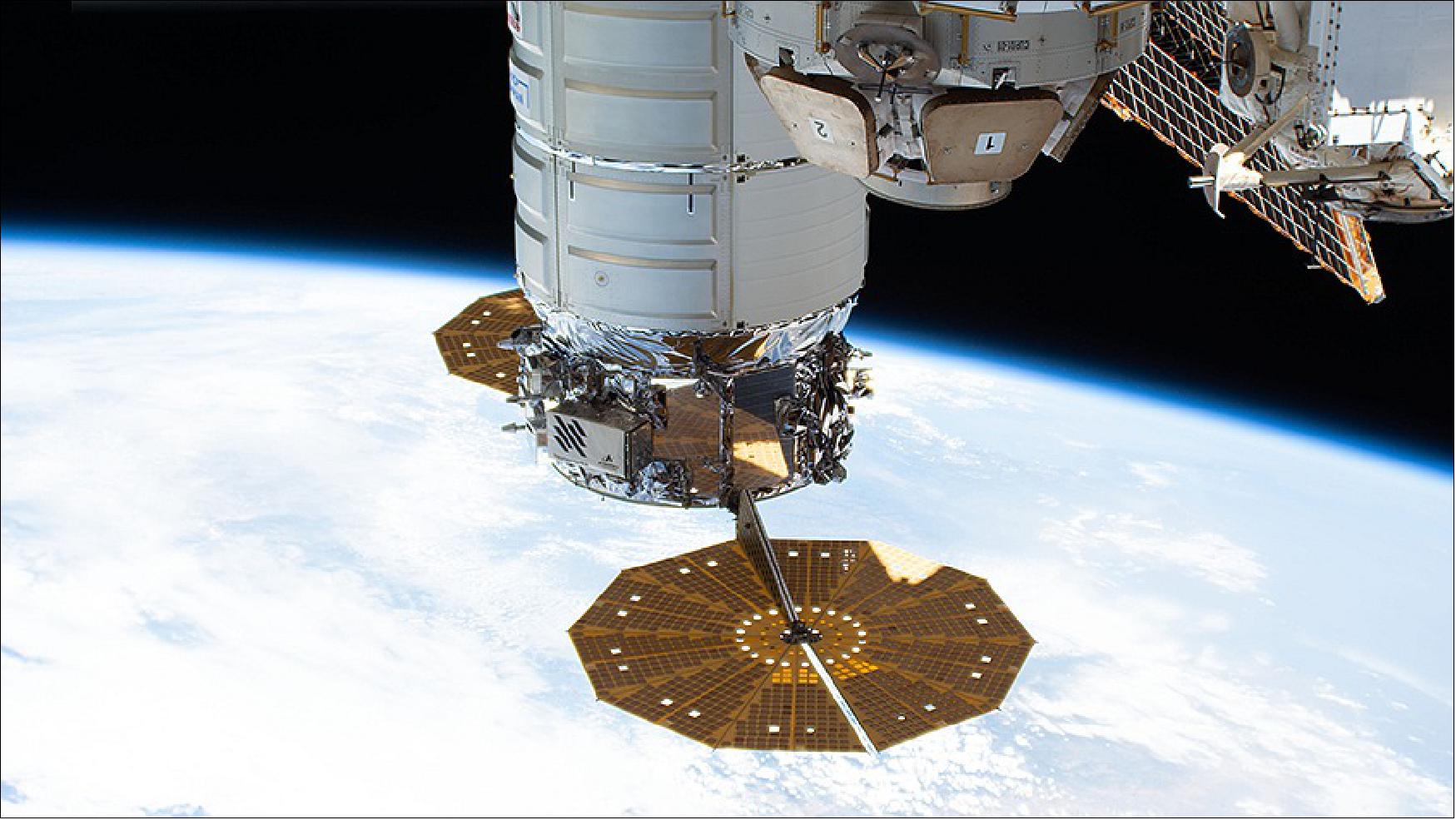
• June 23, 2022: The seven-member Expedition 67 crew split its time with a variety of human research and lab maintenance tasks on Thursday. A U.S. resupply ship is also gearing up for a test of its ability to reboost the International Space Station this weekend before its departure next week. 14)
- NASA and its international partners continuously explore how living in space affects the human body. Numerous experiments investigate how space station crew members adapt to weightlessness during their months-long missions. Scientists on Earth gain insights into how the human physiology changes and inform ways to sustain crew health over the course of a long-term space mission.
- NASA Flight Engineer Kjell Lindgren explored how living in space speeds up aging-like symptoms in humans today. He collected and stowed his blood and urine samples for the Phospho-Aging study that seeks to understand the molecular mechanisms behind the rapid loss of bone and muscle mass that takes place in microgravity. Results may inform countermeasures to keep astronauts healthier longer in space and improve the lives of aging citizens on Earth.
- Astronauts Samantha Cristoforetti of ESA (European Space Agency) and Jessica Watkins of NASA worked throughout Thursday on station upkeep activities. Cristoforetti replaced centrifuge components inside the BioLab, a research facility that studies the effects of space and radiation on single celled and multi-cellular organisms. Watkins rearranged computer hardware and installed new science computer software in the Destiny laboratory module.
- NASA astronaut Bob Hines, along with Lindgren, trained on a computer to remain proficient in SpaceX Crew Dragon vehicle operations. Hines also joined Watkins continuing to film and narrate station operations for downlinking to train astronauts scheduled on future missions.
- Cosmonauts Oleg Artemyev and Sergey Korsakov attached sensors to themselves today monitoring their cardiac activity. Artemyev then activated Earth observation gear while Korsakov unpacked Russian cargo and worked on hatch sealing mechanisms. Flight Engineer Denis Matveev configured radiation detectors and measured the radiation environment aboard the orbiting lab.
- NASA and Northrop Grumman have given the go for Cygnus to try another reboost attempt on Saturday that would lead to Cygnus potentially departing the station on Tuesday, June 28. The reboost is designed to provide Cygnus with an enhanced capability for station operations as a standard service for NASA.
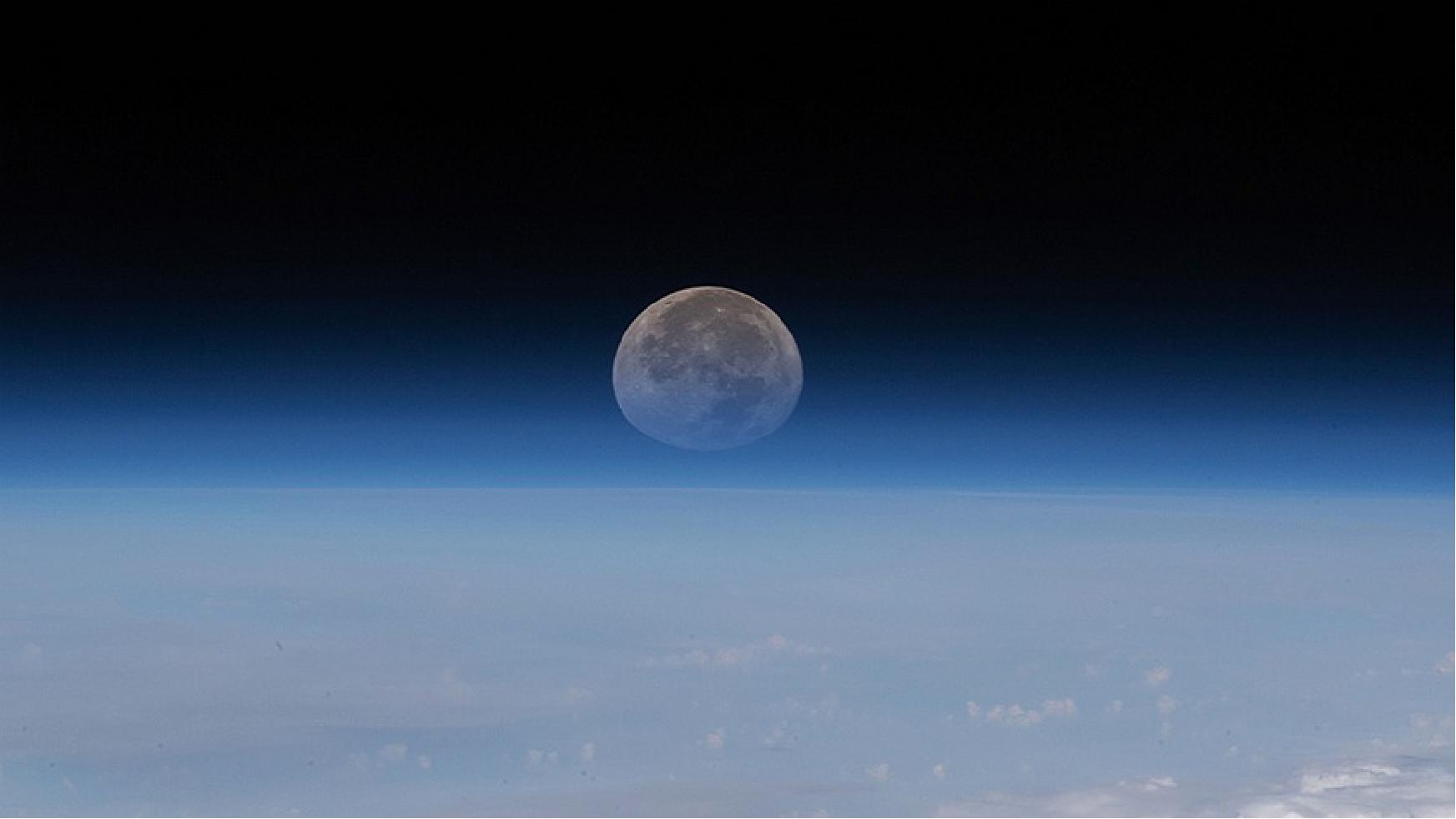
• June 22, 2022: Space gardening and the human digestive system were at the top of the science schedule aboard the International Space Station on Wednesday. The seven Expedition 67 residents also worked throughout the day filming their activities, inspecting station hardware, and testing a new robotic arm. 15)
- Space agriculture is a way to sustain healthy astronauts on future missions to the Moon, Mars and beyond without relying on packed cargo missions traveling farther in space. The XROOTS experiment on the orbiting lab is exploring growing radishes and mizuna greens using hydroponic and aeroponic techniques. NASA Flight Engineer Bob Hines nourished those plants today and checked seed cartridges and wicks to ensure they germinate and grow.
- Hines also inspected and photographed the condition of windows in the Destiny laboratory and the Kibo laboratory modules. NASA Flight Engineer Kjell Lindgren continued testing a headset that enables 3-D high definition holograms in real-time for immersive and innovative communication and research techniques. He also swapped hard drives on a station laptop computer.
- Flight Engineers Jessica Watkins and Samantha Cristoforetti joined each other today inspecting and cleaning hatch components on the U.S. modules. Watkins also audited, inspected, and stowed hardware in the Tranquility module and the Quest airlock. Cristoforetti checked smoke detectors in the Columbus laboratory module and tested a specialized garment that can monitor an astronaut’s health wirelessly.
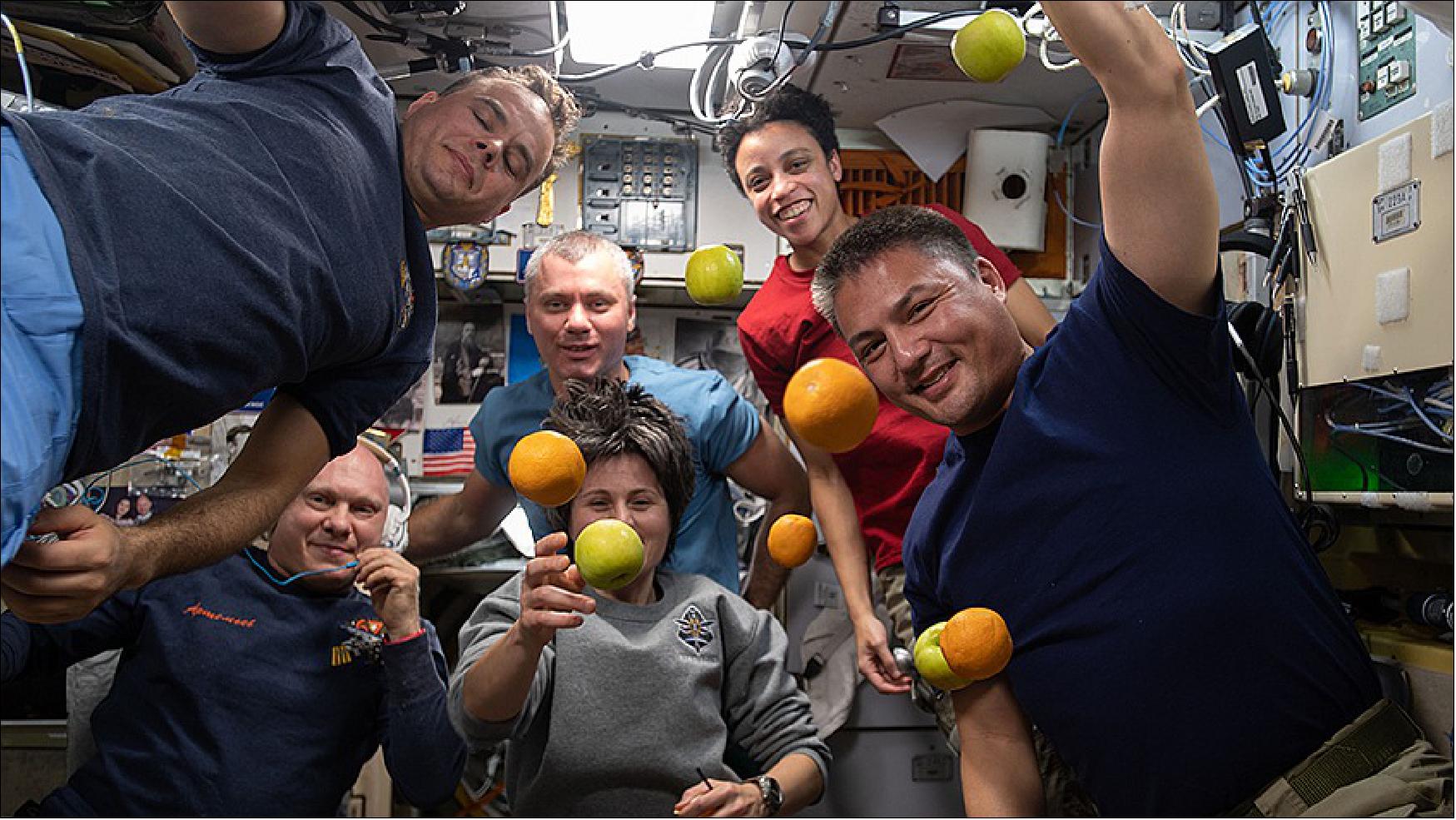
- All four astronauts have also been filming their activities this week to prepare future crews training for upcoming station missions. The quartet have been recording, narrating, and downlinking videos documenting the operation of exercise equipment, network communications gear, and cargo stowage aboard the space station.
- The lack of gravity affects the human body in a multitude of ways. Scientists observe station crew members during long-term missions to understand and counteract the undesired effects of weightlessness. Commander Oleg Artemyev and Flight Engineer Denis Matveev once again scanned their digestive system using an ultrasound device after breakfast. Researchers are exploring how organs and vessels in the gastrointestinal tract adapt to spaceflight.
- Robotics testing is still ongoing this week in the station’s Russian segment. Roscosmos Flight Engineer Sergey Korsakov continued checking out and filming the European robotic arm, the station’s third and newest robotic manipulator, and its ability to maneuver on the Nauka multipurpose laboratory module.
- NASA and Northrop Grumman are continuing to work on a plan for Cygnus to try another reboost attempt as early as Saturday, June 25, that would lead to Cygnus potentially departing the station next Tuesday, June 28. The plan is being discussed with the International Space Station partners this week and a forward plan is expected as early as Thursday.
- The reboost is designed to provide Cygnus with an enhanced capability for station operations as a standard service for NASA.
• June 17, 2022: Space research hardware kept the Expedition 67 crew busy on Friday as the four astronauts and three cosmonauts turned on free-flying robots, configured nanosatellites, and replaced a fuel bottle inside a furnace. The septet also split its day inside the International Space Station with Earth observations, spacesuit helmet work, and cargo packing. 16)
- The Astrobee robotic assistants were flying autonomously inside the Kibo laboratory module today streaming video of their activities to mission controllers on Earth. NASA Flight Engineer Bob Hines configured the cube-shaped Astrobees to test their ability to navigate and visualize the inside of Kibo on their own.
- ESA (European Space Agency) astronaut Samantha Cristoforetti swapped a fuel bottle inside the Electrostatic Levitation Furnace that enables safe observations of high-temperature phenomena in microgravity. She started the day partnering with NASA Flight Engineer Jessica Watkins collecting blood samples and processing them in a centrifuge. Watkins also photographed Earth landmarks in North America, Spain, and Africa while verbally providing descriptions to assist researchers on the ground.
- NASA Flight Engineer Kjell Lindgren checked out components on a U.S. spacesuit helmet before continuing to pack Northrop Grumman’s Cygnus space freighter. Cristoforetti and Watkins both joined Lindgren at the end of the day as they loaded Cygnus with trash and discarded gear ahead of its departure later this month.
- In the Russian segment of the orbiting lab, Commander Oleg Artemyev tested a set of nanosatellites before their future deployment. He also assisted Cristoforetti while she pedaled on an exercise cycle for a physical fitness evaluation. Flight Engineer Denis Matveev spent Friday servicing a Russian oxygen generator while Flight Engineer Sergey Korsakov worked on configuration tasks and computer maintenance inside the Nauka multipurpose laboratory module.
- The International Space Station Flight Control Team has decided to postpone the first limited reboost of the International Space Station by the Northrop Grumman Cygnus resupply vehicle from Saturday to Monday to refine the duration and magnitude of the activity in the wake of Thursday’s debris avoidance maneuver. The postponement will have no impact on station operations.
- This Cygnus mission is the first to feature this enhanced capability as a standard service for NASA, following a test of the maneuver which was performed in 2018 during Cygnus’s ninth resupply mission. Cygnus arrived at the orbital outpost in February and is slated to depart from the space station later this month when it will be deorbited to burn up harmlessly in the Earth’s atmosphere.
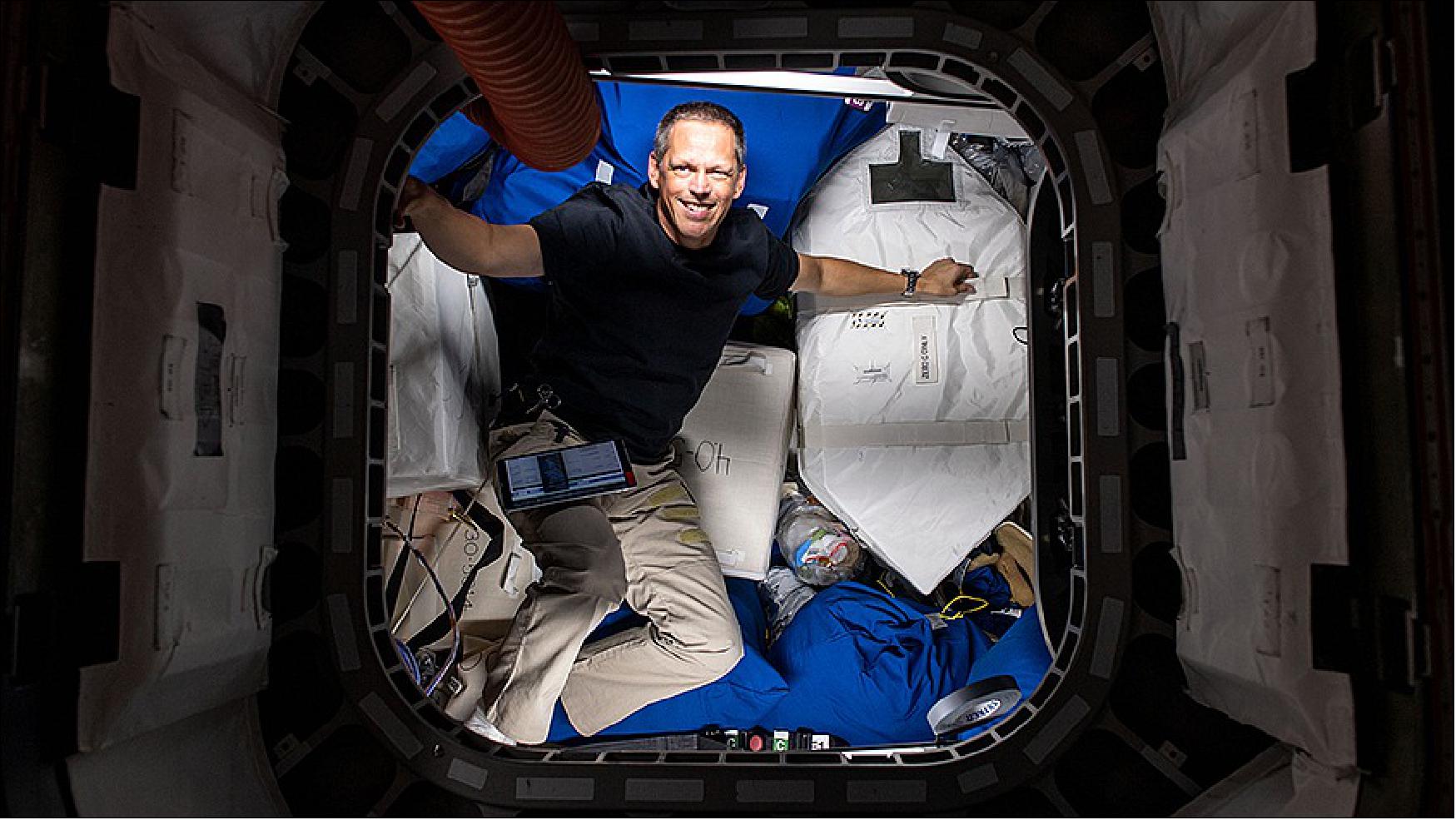
• June 16, 2022: Life Science, Debris Avoidance Maneuver Takes Place on Station. 17)
- The Expedition 67 crew studied advanced physics, continued its human research, and worked on space gardening inside the International Space Station on Thursday. The orbital residents are also readying the Cygnus space freighter for its departure next week.
- NASA Flight Engineer Jessica Watkins split her day between physics research hardware and sample processing. She stowed components from the Transparent Alloys industrial manufacturing experiment and returned the Microgravity Science Glovebox to its standard configuration. Watkins also collected blood and urine samples throughout the day and stowed them in a science freezer for future analysis.
- Space botany and fluid physics were on the research schedule as well for Flight Engineers Kjell Lindgren of NASA and Samantha Cristoforetti of ESA (European Space Agency). Lindgren nourished radishes and mizuna greens growing for the XROOTS hydroponics and aeroponics study. Cristoforetti ran a pair of experiment sessions for the Fluidics study that is exploring how fuel behaves in microgravity.
- NASA astronaut Bob Hines worked on communications hardware and serviced centrifuge components inside the Human Research Facility. Hines also worked throughout the day with Lindgren, Watkins, and Cristoforetti loading the Cygnus resupply ship with trash and discarded gear ahead of its departure on June 23. NASA TV will broadcast Cygnus’ release from the Canadarm2 robotic arm on the agency’s app and website.
- The orbiting lab’s three cosmonauts focused on their complement of research today exploring how to improve space operations. Commander Oleg Artemyev and Flight Engineer Sergey Korsakov took turns participating in an investigation that may inform piloting and robotics control techniques on future planetary missions. Flight Engineer Denis Matveev set up dosimeters for a long-running radiation detection experiment before removing a sensor that monitored his heart activity for 24 hours.
- This afternoon, the International Space Station’s Progress 81 thrusters fired for 4 minutes, 34 seconds in a Pre-Determined Debris Avoidance Maneuver (PDAM) to provide the complex and extra measure of distance away from the predicted track of a fragment of Russian Cosmos 1408 debris.
- The thruster firing occurred at 2:03 p.m. Central time. The crew was never in any danger and the maneuver had no impact on station operations.
- Without the maneuver, it was predicted that the fragment could have passed within around a half mile from the station.
- The PDAM increased the station’s altitude by 3/10 of a mile at apogee and 7/10 of a mile at perigee and left the station in an orbit of 261.2 x 257.3 statute miles.
- The scheduled reboost of the station on Saturday to test Northrop Grumman’s Cygnus NG-17 vehicle’s reboost capability for the first time will still be conducted, but with a slightly reduced engine firing duration to preserve the phasing for Russian Soyuz launch and landing operations in September.
- On Saturday, June 18, the Cygnus spacecraft will perform its first limited reboost of the International Space Station. Cygnus’s gimbaled delta velocity engine will be used to adjust the space station’s orbit through a reboost of the altitude of the space station. This Cygnus mission is the first to feature this enhanced capability as a standard service for NASA, following a test of the maneuver which was performed in 2018 during Cygnus’s ninth resupply mission. Cygnus arrived to the orbital outpost in February and is slated to depart from space station later this month where it will burn up harmlessly in the Earth’s atmosphere.
• June 6, 2022: NASA and SpaceX have postponed the launch of a cargo Dragon mission to the International Space Station after discovering a potential propellant leak in the spacecraft’s thrusters. 18)
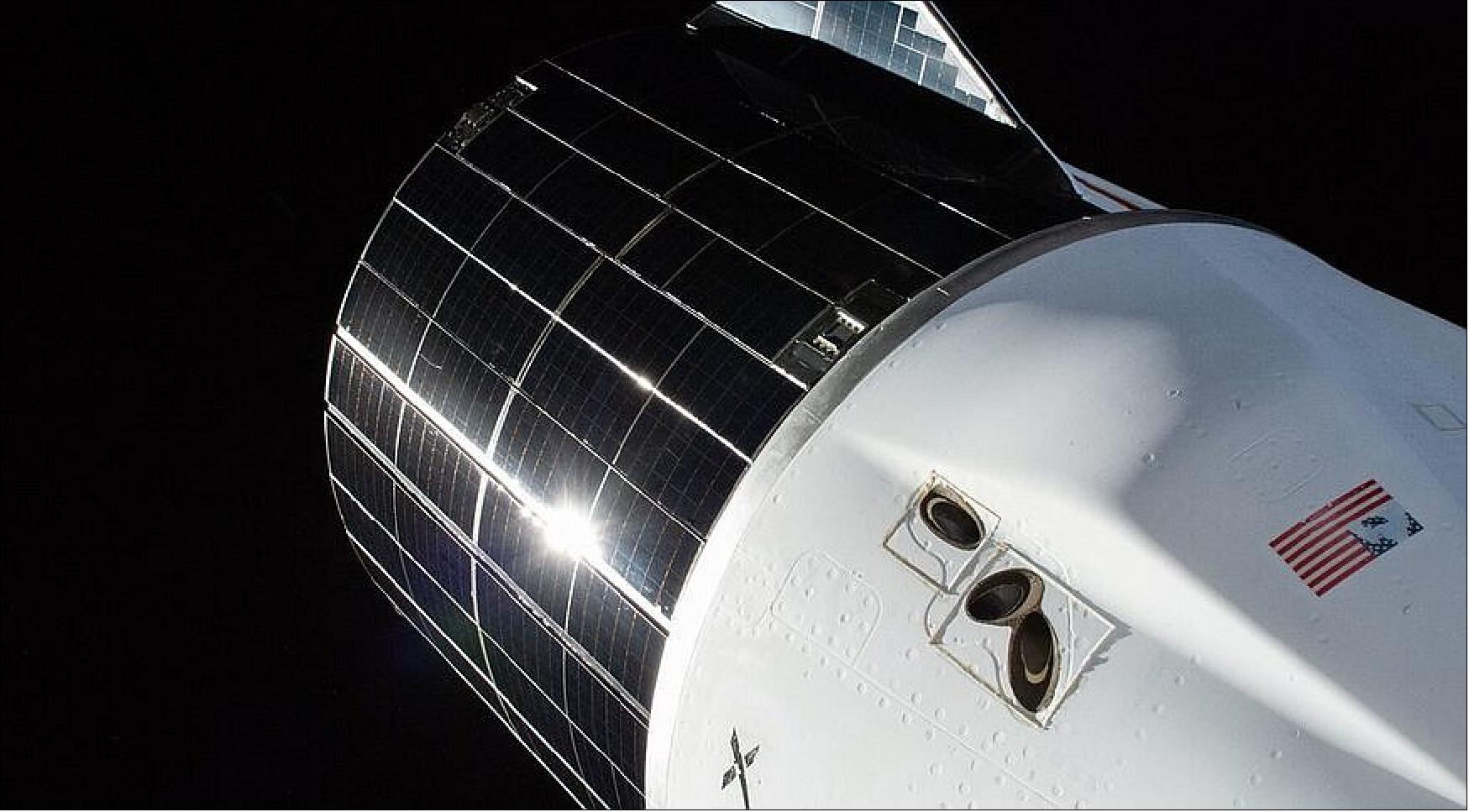
- In a statement late June 6, NASA said the launch of the CRS-25 mission, which had been scheduled for June 10, would be postponed after detecting “elevated vapor readings” of monomethyl hydrazine (MMH) in a portion of the spacecraft’s Draco thruster system. The cause of the elevated reading is under investigation.
- The Dragon spacecraft uses Draco thrusters for orbital maneuvers, including approaching and departing the space station and to deorbit at the end of the mission. The thrusters use MMH and nitrogen tetroxide propellants, a storable, hypergolic combination. The cargo version of Dragon lacks the more powerful SuperDraco thrusters SpaceX developed for the abort system on the Crew Dragon spacecraft.
- NASA said the elevated readings were detected when propellant was loaded into the spacecraft, but did not state when that took place other that the problem was “identified over the weekend.” NASA and SpaceX officials said they met June 6 to discuss the issue “and the best path forward.”
- The agency said that the MMH and nitrogen tetroxide propellants had been offloaded from Dragon to allow engineers to investigate the problem. “Once the exact source of the elevated readings is identified and cause is determined, the joint NASA and SpaceX teams will determine and announce a new target launch date,” it stated.
- The Dragon will deliver more than two tons of supplies and equipment to the ISS. Among the science payloads on the mission, highlighted in a NASA briefing June 2, include an Earth science instrument (ISS-EMIT) that will study mineral dust in the atmosphere, experiments to study how sutured wounds heal in microgravity and aging of the immune system, and a student-developed experiment that will use biopolymers to create bricks from materials like those found in lunar and Martian regolith.
- The thruster problem is the second issue to involve a Dragon spacecraft in recent weeks. NASA said May 24 that SpaceX was replacing the heat shield structure for the next Crew Dragon spacecraft, which will launch in September on the Crew-5 mission. That heat shield failed an acceptance test earlier in May.
• June 6, 2022: NASA and SpaceX are standing down from this week’s Falcon 9 launch of the CRS-25 cargo mission to the International Space Station. Officials from NASA and SpaceX met today to discuss an issue identified over the weekend and the best path forward. 19)
- During propellant loading of the Dragon spacecraft, elevated vapor readings of mono-methyl hydrazine (MMH) were measured in an isolated region of the Draco thruster propulsion system. The propellant and oxidizer have been offloaded from that region to support further inspections and testing. Once the exact source of the elevated readings is identified and cause is determined, the joint NASA and SpaceX teams will determine and announce a new target launch date.
- In the meantime, Flight Engineers Jessica Watkins of NASA and Samantha Cristoforetti of ESA (European Space Agency) are getting up to speed with the Dragon cargo craft’s rendezvous and docking procedures. The duo trained on a computer on Monday to prepare for their roles when they monitor Dragon’s automated arrival and docking.
- Eye exams were on the schedule with NASA Flight Engineer Kjell Lindgren taking charge as Crew Medical Officer today. He operated medical imaging gear, using standard optical coherence tomography techniques, and scanned the eyes and retinas of Cristoforetti and NASA Flight Engineer Bob Hines.
- Before beginning his eye exam, Hines cleaned up and stowed obsolete combustion research hardware to make room for newer science gear being delivered on upcoming resupply missions. The first time space-flyer also worked on light orbital plumbing duties and recirculated fluids to support plants growing for the XROOTS space botany study.
- Lindgren started his day in the Quest airlock servicing U.S spacesuits. The first time space-flyer collected water samples from the suit cooling loops and cleaned their water lines before installing new components. Watkins completed the spacesuit work in the afternoon following her Dragon rendezvous training.
- In the station’s Russian segment, Commander Oleg Artemyev and Flight Engineer Sergey Korsakov took turns exploring ways to maximize and monitor the effectiveness of physical exercise in space. Artemyev also updated cargo inventory systems as Korsakov unpacked supplies from inside the new Progress 81 resupply ship. Flight Engineer Denis Matveev installed Earth observation gear before photographing the inside of the Nauka multipurpose laboratory module4 for inspection purposes.
• June 3, 2022: An uncrewed Russian Progress 81 spacecraft arrived at the International Space Station’s Zvezda service module at 9:02 a.m. EDT, two orbits after launch from the Baikonur Cosmodrome in Kazakhstan. 20)
- Progress is delivering almost three tons of food, fuel and supplies to the International Space Station for the Expedition 67 crew.
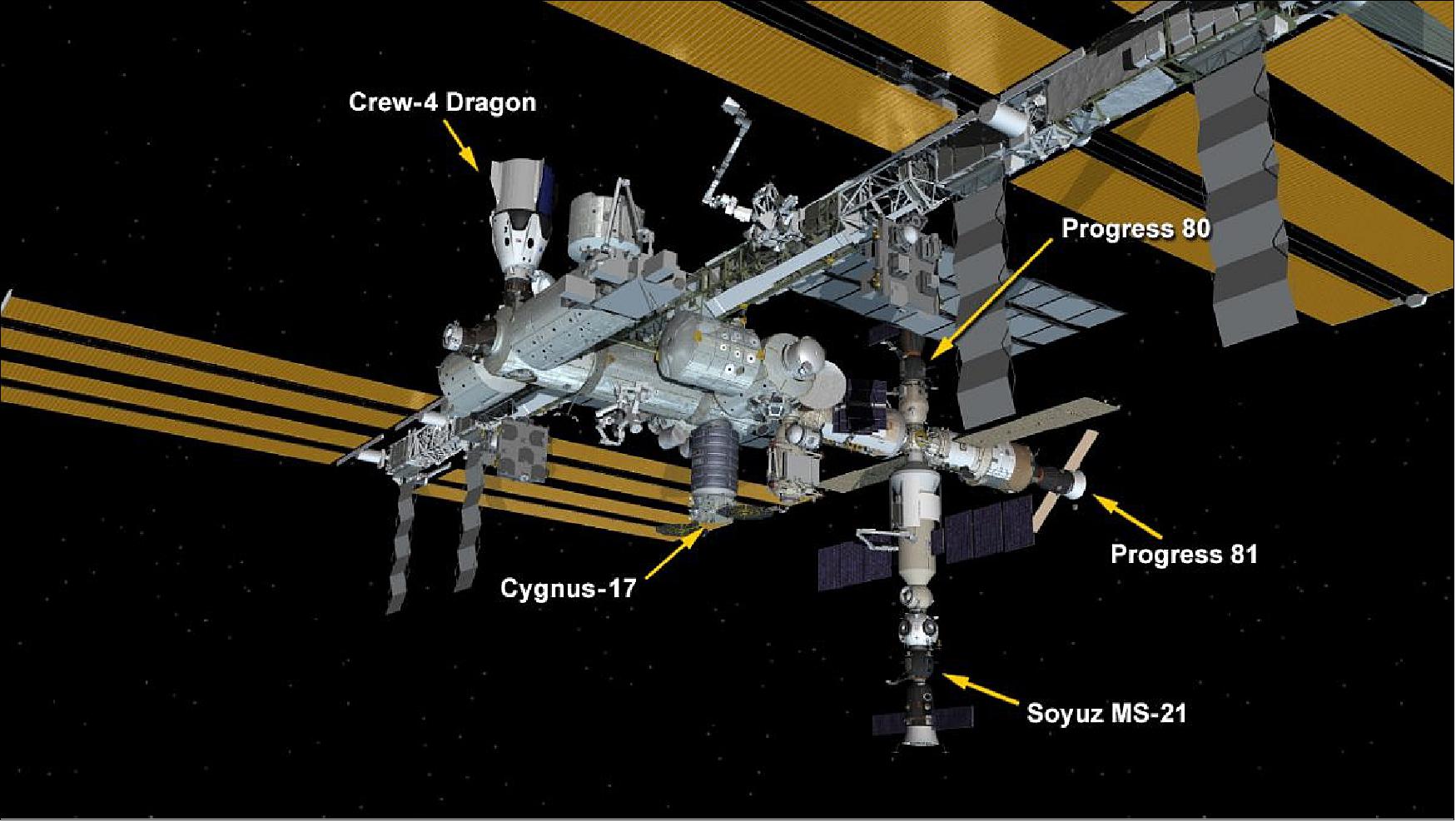
• May 17, 2022: April 2022 was an exciting month for Europe in space. After a few weather-related delays, ESA astronaut Samantha Cristoforetti was launched to the International Space Station on 27 April with Crew-4 for her second mission, Minerva. She was welcomed aboard the International Space Station by Matthias Maurer, marking the first time since 2011 that two ESA astronauts had been together in orbit. 21)
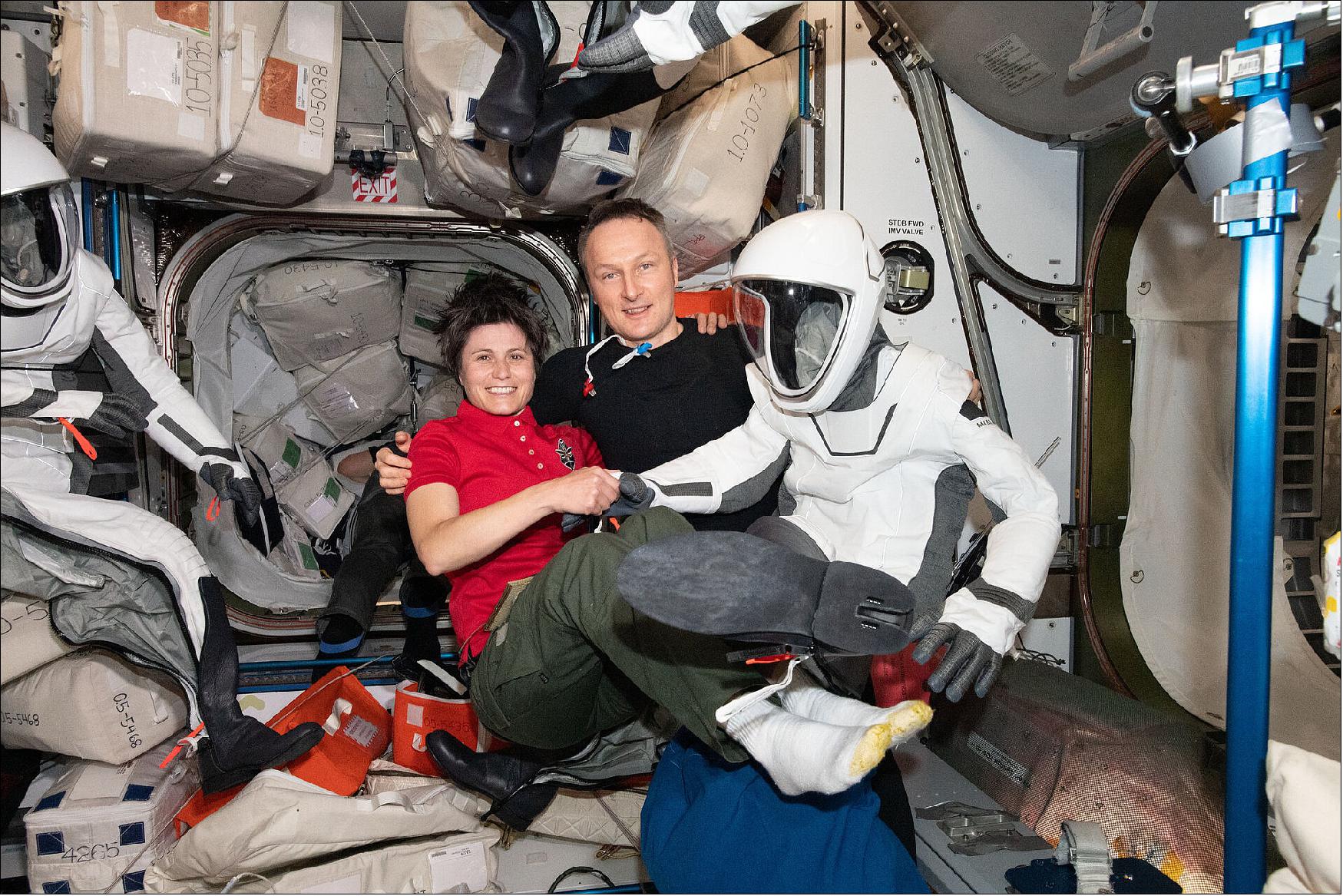
Figure 18: The astronauts’ meeting marks a brief crossover between the start of Samantha’s second space mission, Minerva, and Matthias’s final days in orbit for his first mission, Cosmic Kiss. Matthias is pleased with what he’s achieved in his time on Station, including the science he’s supported and the spacewalk he performed. He wishes Samantha all the best for her mission as she wishes him a safe return to Earth (video credit: ESA/NASA)
- On 9 April, Crew Dragon Endeavour, which previously transported ESA astronaut Thomas Pesquet to and from the Station with Crew-2, arrived with four private crew members on board. Known as Axiom-1, this mission was expected to last just over a week, but nature had other plans. Due to unfavourable conditions at the landing site, the Axiom crew ended up staying 17 days, carrying out much of their mission activity from Europe’s Columbus module.
- Meanwhile, Matthias wasted no time, spending the final month of his mission immersed in science and operations – from arteries to alloys and treadmill maintenance.
Aging Astronaut Arteries
- Did you know, that after six months in space, an astronauts' arteries stiffen by 17% to 30%? This is the equivalent of 10-20 years of normal aging on Earth. Vascular Aging is the latest experiment in the Canadian Space Agency’s Vascular series, which also includes Vascular, Vascular Echo and Vascular Calcium. This experiment series aims to deepen our understanding of the effects of microgravity on the cardiovascular system.
- Vascular and Vascular Echo used blood tests and ultrasound technology to examine astronauts' blood vessels. Vascular Aging and Vascular Calcium aim to investigate other issues known to pose risks to astronauts' health, such as radiation and insulin resistance – a precursor of Type 2 diabetes. Matthias is the fifth of nine astronauts to participate in Vascular Aging and will continue to undergo blood tests and resting ultrasound tests for this experiment on Earth.
Figure 19: Using Space to Fight Cardiovascular Disease with Astronaut Tim Peake (video credit: Canadian Space Agency, NASA)
See-through Science
- One of the experiments that will be ongoing throughout Samantha’s Minerva mission is Transparent Alloys. In April, Matthias placed hardware for the material sciences study in the Microgravity Science Glovebox (MSG) and installed a sample cartridge.
- Alloys are everywhere, from the smartphone in your pocket to aircraft. Making lighter, resistant, self-healing or even supple alloys benefits industry and consumers alike. But to do that, scientists need to improve their understanding of melting-solidification processes in alloys and have sent organic compounds to the Space Station as analogues to experiment with. Each compound was carefully chosen to be transparent, while solidifying like a metal, and is being observed on the Space Station in microgravity.
- Matthias also removed the Solidification and Quenching Furnace (SQF) from the Materials Science Laboratory and installed the Low Gradient Furnace (LGF) for an experiment studying crystal growth that should commence in May. The zinc selenide-based crystals being studied are integral to special optical applications on Earth including infrared lasers and optical wavelength conversion devices.
• May 16, 2022: On the evening of 15 May 2022, Earth passed between the Sun and the Moon blocking sunlight and casting a shadow on the lunar surface. ESA astronaut Samantha Cristoforetti witnessed this lunar eclipse from the International Space Station and captured it in a series of photographs. 22)
- In this image, the Moon appears to play hide and seek with one of the International Space Station's solar panels.
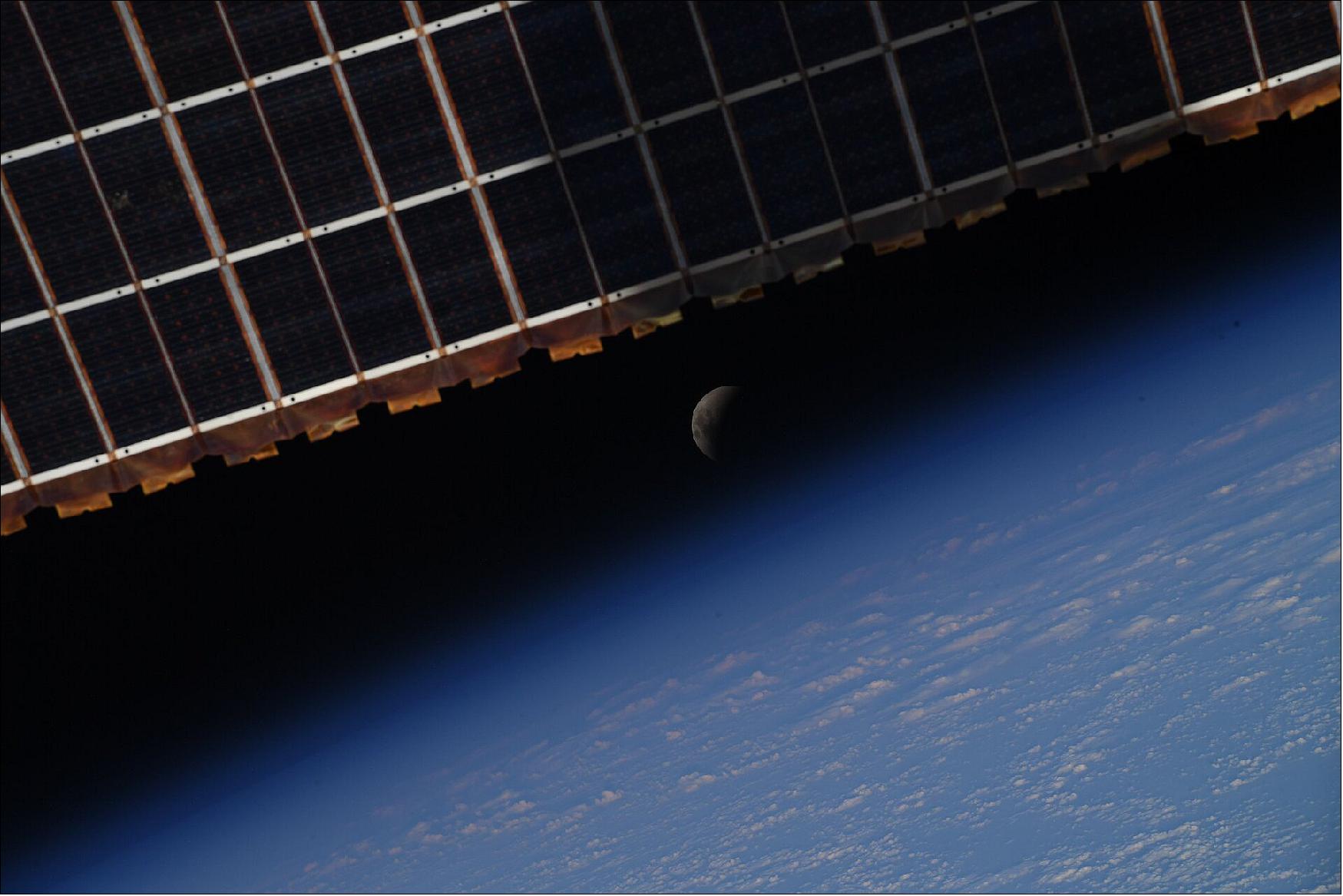
• May 13, 2022: The International Space Station is getting ready to welcome Boeing’s new Starliner crew ship due to lift off next week on the company’s Orbital Flight Test-2 (OFT2) mission. Meanwhile, the seven-member Expedition 67 crew continued its human research and robotics work today. 23)
- NASA Flight Engineers Kjell Lindgren and Bob Hines continued training for the arrival of the Starliner spacecraft targeted for 7:10 p.m. EDT on Friday, May 20. The duo reviewed the OFT-2 mission profile and practiced the remote commanding of Starliner on a computer. The device that sends and receives data from approaching commercial crew vehicles, Common Communications for Visiting Vehicles (C2V2), was activated earlier this week. Starliner will lift off atop the Atlas-V rocket from United Launch Alliance at 6:54 p.m. EDT on Thursday, May 19, from Cape Canaveral Space Force Station in Florida.
- Lindgren and Hines also started the day collecting and stowing their blood samples for later analysis. Hines then activated the Astrobee robotic free-flyer assistants inside the Kibo laboratory module. Lindgren later stowed the toaster-sized, cube-shaped robots after the autonomous devices spent the day demonstrating ways to detect and repair faulty station hardware.
- Astronaut Jessica Watkins familiarized herself with Astrobee procedures and swapped components in the station’s waste and hygiene compartment located in the Tranquility module. Flight Engineer Samantha Cristoforetti from ESA (European Space Agency) spent all day Friday testing the rHEALTH ONE medical device for its ability to identify cells, microorganisms, and proteins in microgravity.
- Over in the station’s Russian segment, Commander Oleg Artemyev worked throughout Friday transferring water from the ISS Progress 80 cargo craft into the Zvezda service module. He also packed old station gear for disposal inside the ISS Progress 79 resupply ship. Flight Engineer Denis Matveev worked on ventilation systems and photographed the condition of panels inside Zvezda. Flight Engineer Sergey Korsakov continued testing the mobility of the European robotic arm attached to the Nauka multipurpose laboratory module.
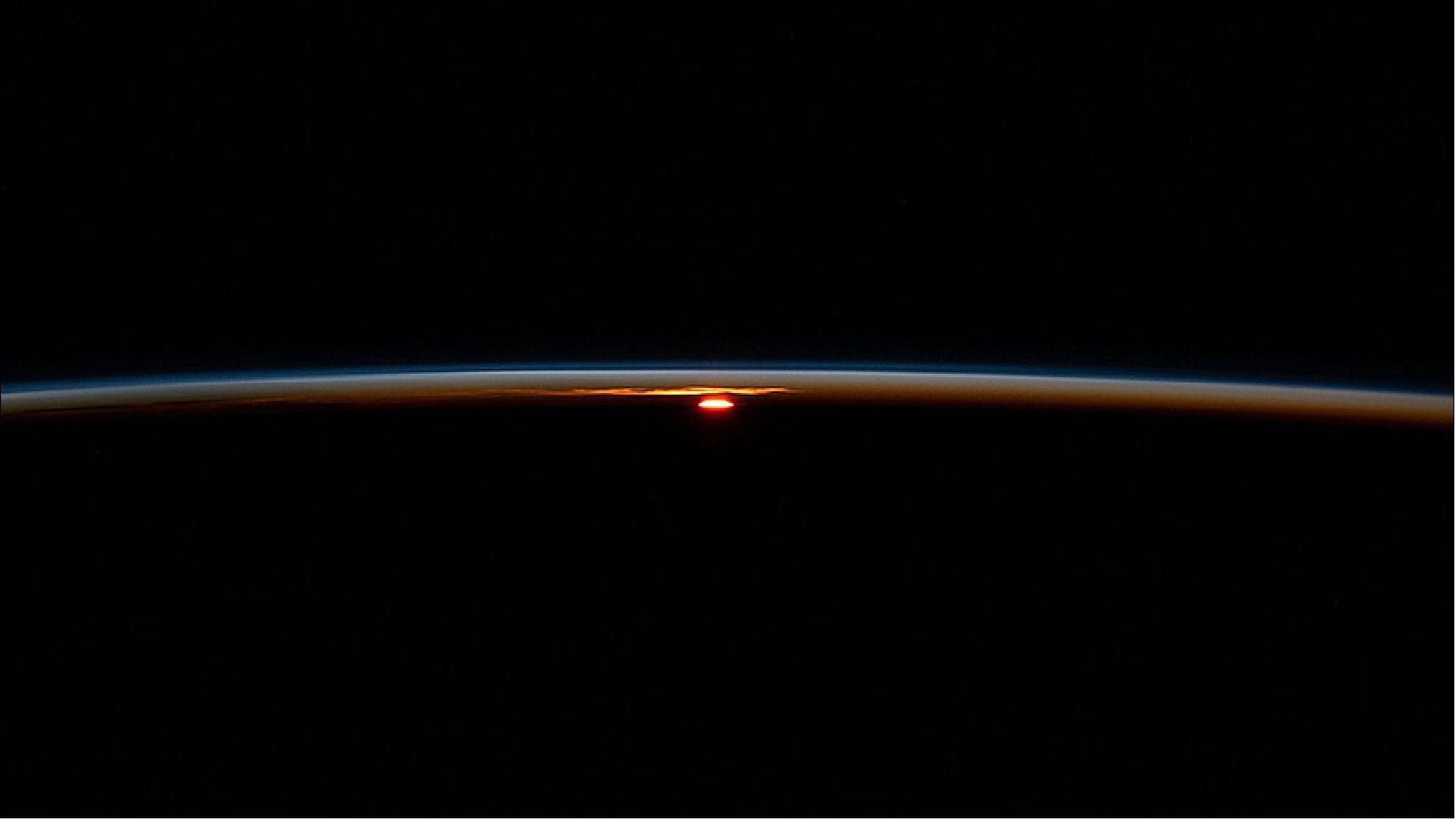
• April 29, 2022: Two Roscosmos cosmonauts went on a spacewalk to activate the new European robotic arm (ERA) less than a day after the SpaceX Crew-4 mission arrived at the International Space Station. The next mission event taking place will occur next week when four Expedition 67 astronauts complete their stay aboard the orbiting lab. 24)
- Cosmonauts Oleg Artemyev and Denis Matveev exited the station in their Orlan spacesuits at 10:58 a.m. EDT on Thursday beginning the fifth spacewalk of the year. Fellow cosmonaut Sergey Korsakov assisted the spacewalkers from inside the station’s Russian segment as they released the ERA from its launch restraints on the Nauka multipurpose laboratory module and monitored the new robotic arm’s first motion.
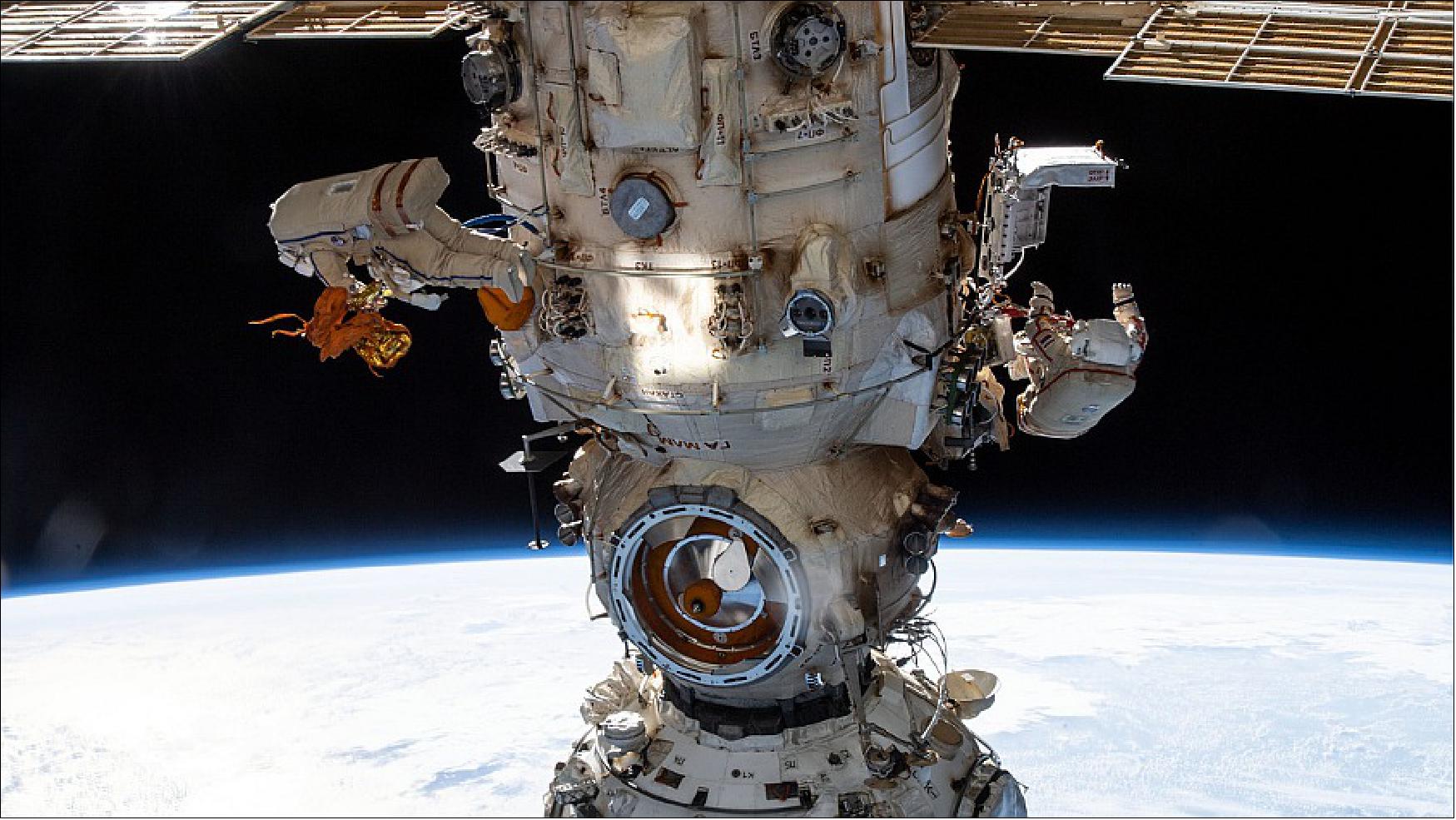
- The day before, the SpaceX Dragon Freedom crew ship, carrying four Crew-4 astronauts, docked to the Harmony module’s space-facing port at 7:37 p.m. EDT. Less than two hours later, NASA astronauts Kjell Lindgren, Robert Hines, and Jessica Watkins with ESA (European Space Agency) astronaut Samantha Cristoforetti, entered the station beginning a four-and-a-half month research mission aboard the space station. The 11-person crew will live and work together until next week when the SpaceX Crew-3 mission ends.
- Station Commander Tom Marshburn along with Flight Engineers Raja Chari, and Kayla Barron, all NASA astronauts, and ESA astronaut Matthias Maurer, are packing up to end their stay on the orbiting lab. The four astronauts representing the Commercial Crew Program are finalizing a six-month science mission on the space lab. NASA and SpaceX mission managers are planning for the quartet to enter the Dragon Endurance crew ship and undock from Harmony’s forward port for a splashdown off the coast of Florida next week.
• April 28, 2022: NASA astronauts Mission Commander Kjell Lindgren, Pilot Bob Hines, and Mission Specialist Jessica Watkins, and Mission Specialist Samantha Cristoforetti of ESA (European Space Agency) now are aboard the International Space Station following Crew Dragon’s hatch opening about 9:15 p.m. EDT, Wednesday, April 27 (01:15 UTC on April 28). 25)
Figure 23: ESA astronaut Samantha Cristoforetti and NASA astronauts Kjell Lindgren, Robert “Bob” Hines and Jessica Watkins arrive at the International Space Station after docking at 01:37 CEST on Thursday 28 April 2022 (video credit: ESA/NASA) 26)
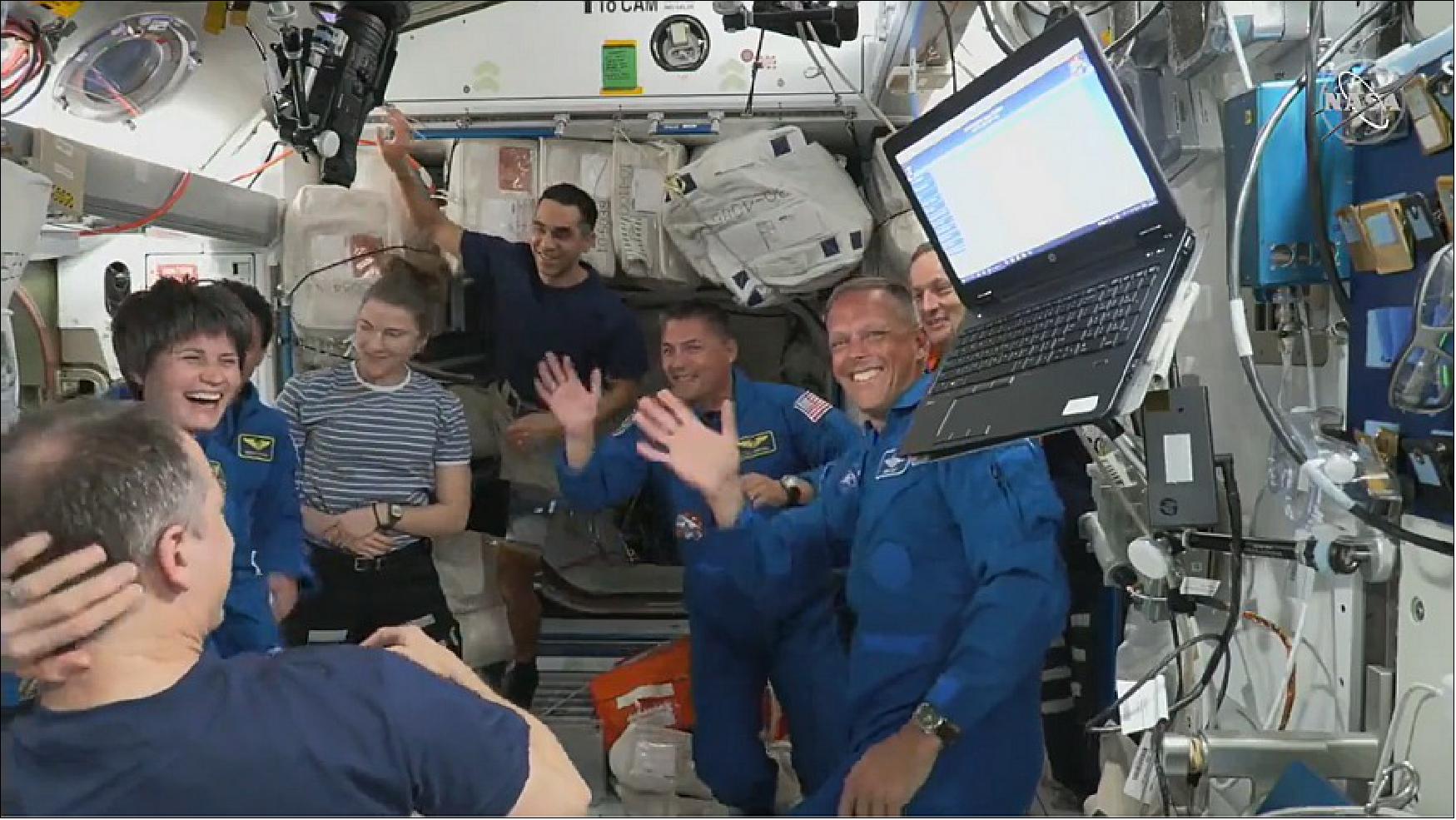
- Crew-4 joins Expedition 67 crew of Raja Chari, Thomas Marshburn, and Kayla Barron, all of NASA, Matthias Maurer of ESA, and cosmonauts Oleg Artemyev, Sergey Korsakov, and Denis Matveev of Roscosmos.
- NASA TV coverage will conclude shortly after hatch opening and return for live coverage of the welcoming ceremony at 2:40 a.m. Thursday, April 28.
- Crew-4 astronauts launched to International Space Station at 3:52 a.m. Wednesday, April 27, from Launch Complex 39A at NASA’s Kennedy Space Center in Florida. The international crew of four will spend several months on the orbital complex on a science expedition mission.
• April 27, 2022: NASA astronauts Kjell Lindgren, Bob Hines, and Jessica Watkins, and ESA (European Space Agency) astronaut Samantha Cristoforetti arrived at the International Space Station Wednesday, April 27, as the SpaceX Dragon Freedom docked to the complex at 7:37 p.m. EDT (23:37 UTC) while the spacecraft were flying about 261 miles (420 km) above the Pacific Ocean. 27)
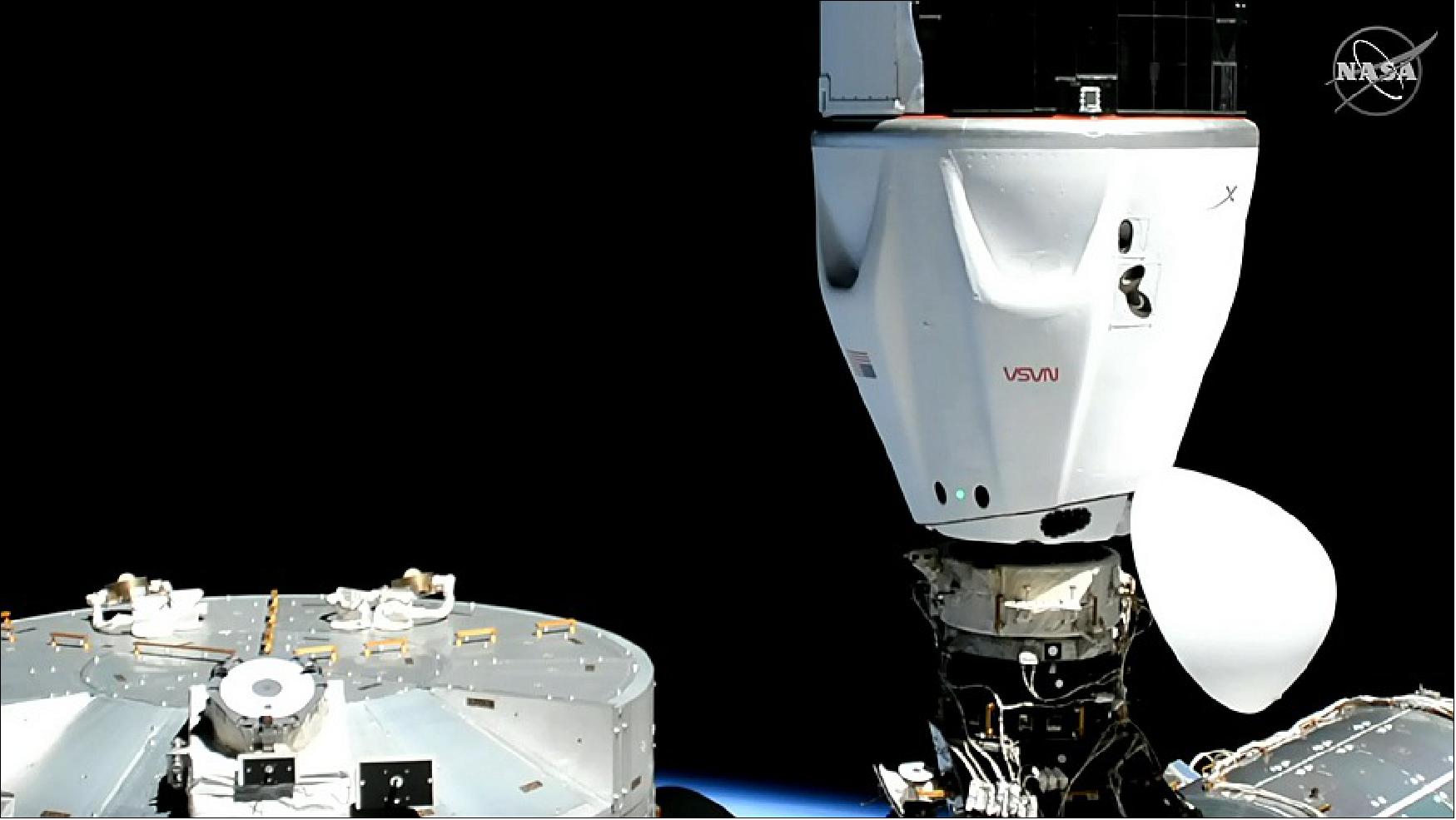
- Following Crew Dragon’s link up to the Harmony module, the astronauts aboard Dragon and the space station will begin conducting standard leak checks and pressurization between the spacecraft in preparation for hatch opening.
- Lindgren, Hines, Watkins, and Cristoforetti will join the Expedition 67 crew of Raja Chari, Thomas Marshburn, and Kayla Barron, all of NASA, Matthias Maurer of ESA, and cosmonauts Oleg Artemyev, Sergey Korsakov, and Denis Matveev of Roscosmos. For a short time, the number of crew on the space station will increase to 11 people until NASA’s SpaceX Crew-3 departs in early May.
References
1) Jeff Foust, ”Falcon 9 launches Crew-4 mission to space station,” SpaceNews, 27 April 2022, URL: https://spacenews.com/falcon-9-launches-crew-4-mission-to-space-station/
2) ”NASA’s SpaceX Crew-4 Astronauts Launch to International Space Station,” NASA Press Release 22-037, 27 April 2022, URL: https://www.nasa.gov/press-release/nasa-s-spacex-crew-4-astronauts-launch-to-international-space-station
3) Jason Costa, ”NASA’s SpaceX Crew-4 Underway as Freedom Journeys to Station,” NASA's SpaceX Crew-4 Mission, 27 April 2022, URL: https://blogs.nasa.gov/crew-4/2022/04/27/nasas-spacex-crew-4-underway-as-freedom-journeys-to-station/
4) ”Smiling Sam,” ESA Science & Exploration, 25 April 2022, URL: https://www.esa.int/ESA_Multimedia/Images/2022/04/Smiling_Sam
5) Jason Costa, ”Crew-4 Dragon Rolls to the Pad, Completes Dry Dress Rehearsal,” NASA's SpaceX Crew-4 Mission, 20 April 2022, URL: https://blogs.nasa.gov/crew-4/2022/04/20/crew-4-dragon-rolls-to-the-pad-completes-dry-dress-rehearsal/
6) ”Watch live: media Q&A with Samantha Cristoforetti,” ESA Science & Applications, 8 April 2022, URL: https://www.esa.int/Science_Exploration/Human_and_Robotic_Exploration/Minerva/Watch_live_media_Q_A_with_Samantha_Cristoforetti
7) Kathleen Ellis, ”NASA, SpaceX Adjust Target Launch Date for Crew-4 Mission,” NASA Crew-4, 18 March 2022, URL: https://blogs.nasa.gov/crew-4/2022/03/
8) ”Looking four-ward to launch,” ESA Science & Exploration, 1 February 2022, URL: https://www.esa.int/ESA_Multimedia/Images/2022/02/Looking_four-ward_to_launch
9) ”Minerva mission patch,” ESA Science & Exploration, 10 March 2022, URL: https://www.esa.int/Science_Exploration/Human_and_Robotic_Exploration/Minerva/Watch_live_media_Q_A_with_Samantha_Cristoforetti
10) ”NASA Assigns Astronaut Jessica Watkins to NASA’s SpaceX Crew-4 Mission,” NASA Press Release 21-155, 16 November 2021, URL: https://www.nasa.gov/press-release/nasa-assigns-astronaut-jessica-watkins-to-nasa-s-spacex-crew-4-mission
11) ”Cygnus departure from Space Station,” ESA Science & Exploration, 01 July 2022, URL: https://www.esa.int/About_Us/Week_in_images/Week_in_images_27_June_-_1_July_2022
12) Mark Garcia, ”NASA, SpaceX Target New Launch Date for Commercial Cargo Mission,” NASA Space Station, 28 June 2022, URL: https://blogs.nasa.gov/spacestation/2022/06/28/nasa-spacex-target-new-launch-date-for-commercial-cargo-mission/
13) Mark Garcia, ”Cygnus Cargo Craft Fires Engine for Limited Station Reboost,” NASA Space Station, 25 June 2022, URL: https://blogs.nasa.gov/spacestation/2022/06/25/cygnus-cargo-craft-fires-engine-for-limited-station-reboost/
14) Mark Garcia, ”Aging, Heart Studies on Station Ahead of Cygnus Reboost Test,” NASA Space Station, 23 June 2022, URL: https://blogs.nasa.gov/spacestation/
15) Mark Garcia, ”Space Gardening, Digestion, and Robotics Top Crew Schedule,” NASA Space Station, 22 June 2022, URL: https://blogs.nasa.gov/spacestation/
16) Mark Garcia, ”Crew Wraps Week with Research Hardware Work, Cygnus Packing,” NASA Space Station, 17 June 2022, URL: https://blogs.nasa.gov/spacestation/2022/06/17/crew-wraps-week-with-research-hardware-work-cygnus-packing/
17) Mark Garcia, ”Life Science, Debris Avoidance Maneuver Takes Place on Station,” 16 June 2022, URL: https://blogs.nasa.gov/spacestation/2022/06/16/life-science-debris-avoidance-maneuver-takes-place-on-station/
18) Jeff Foust, ”Cargo Dragon mission postponed to investigate potential propellant leak,” SpaceNews, 6 June 2022, URL: https://spacenews.com/cargo-dragon-mission-postponed-to-investigate-potential-propellant-leak/
19) Mark Garcia, ”Dragon Mission on Hold as Astronauts Conduct Eye Exams, Spacesuit Work,” 6 June 2022, URL: https://blogs.nasa.gov/spacestation/2022/06/06/dragon-mission-on-hold-as-astronauts-conduct-eye-exams-spacesuit-work/
20) Mark Garcia, ”Progress Cargo Craft Docks to Station after Two Orbits,” NASA Space Station, 3 June 2022, URL: https://blogs.nasa.gov/spacestation/2022/06/03/progress-cargo-craft-docks-to-station-after-two-orbits/
21) ”April in orbit: two ESA astronauts and plenty of science,” ESA Science & Exploration, 15 May 2022, URL: https://www.esa.int/Science_Exploration/Human_and_Robotic_Exploration/April_in_orbit_two_ESA_astronauts_and_plenty_of_science
22) ”Peek-a-boo Moon,” ESA Science & Exploration,” 16 May 2022, URL: https://www.esa.int/ESA_Multimedia/Images/2022/05/Peek-a-boo_Moon
23) Mark Garcia, ”Crew Preps for Starliner During Human Research and Robotics,” NASA Space Station, 13 May 2022, URL: https://blogs.nasa.gov/spacestation/2022/05/13/crew-preps-for-starliner-during-human-research-and-robotics/
24) Heidi Lavelle, ”Expedition 67 Crew Wraps Up Week After Crew Arrival and Spacewalk,” NASA Space Station, 29 April 2022, URL: https://blogs.nasa.gov/spacestation/2022/04/29/expedition-67-crew-wraps-up-week-after-crew-arrival-and-spacewalk/
25) Heidi Lavelle, ”Crew-4 Now Aboard the Space Station,” NASA Space Station, 28 April 2022, URL: https://web.archive.org/web/20220520182502/https://blogs.nasa.gov/spacestation/2022/04/27/crew-4-now-aboard-the-space-station/
26) ”Samantha Cristoforetti and the rest of Crew-4 arrives at the International Space Station,” ESA Science & Exploration, 28 April 2022, URL: https://www.esa.int/ESA_Multimedia/Videos/2022/04/Samantha_Cristoforetti_and_the_rest_of_Crew-4_arrives_at_the_International_Space_Station
27) Heidi Lavelle, ”The Crew-4 Astronauts Dock to the Space Station,” NASA Space Station, 27 April 2022, URL: https://blogs.nasa.gov/spacestation/2022/04/27/the-crew-4-astronauts-dock-to-the-space-station/
The information compiled and edited in this article was provided by Herbert J. Kramer from his documentation of: ”Observation of the Earth and Its Environment: Survey of Missions and Sensors” (Springer Verlag) as well as many other sources after the publication of the 4th edition in 2002. Comments and corrections to this article are always welcome for further updates (eoportal@symbios.space).